There is a wide range of snakes that make Mississippi their home, only a small percentage are venomous.
While the majority of snakes in the state are non-venomous, encounters with venomous snakes do occur and knowing how to identify the snakes and what to do if you encounter one is important.
Continue reading below to find out more about the snakes you may encounter when living or visiting Mississippi.
Table of Contents
Are There Venomous Snakes in Mississippi
There are seven venomous snakes you need to know in Mississippi. If you happen to come across one of these snakes, stay as far away as possible. If you are bitten, seek urgent medical treatment.
If you are bitten by a snake, you must call 911 immediately. It’s important to remain calm and take a description or photograph of the snake. This helps responders identify the right treatment.
Keep the bite area lower than your heart, washing the area with warm soapy water. Cover it, helping the bite area remain clean and dry. Do not drink alcohol or caffeinated beverages.
7 Venomous Snakes in Mississippi
The seven venomous snakes in Mississippi include:
1. Northern Cottonmouth
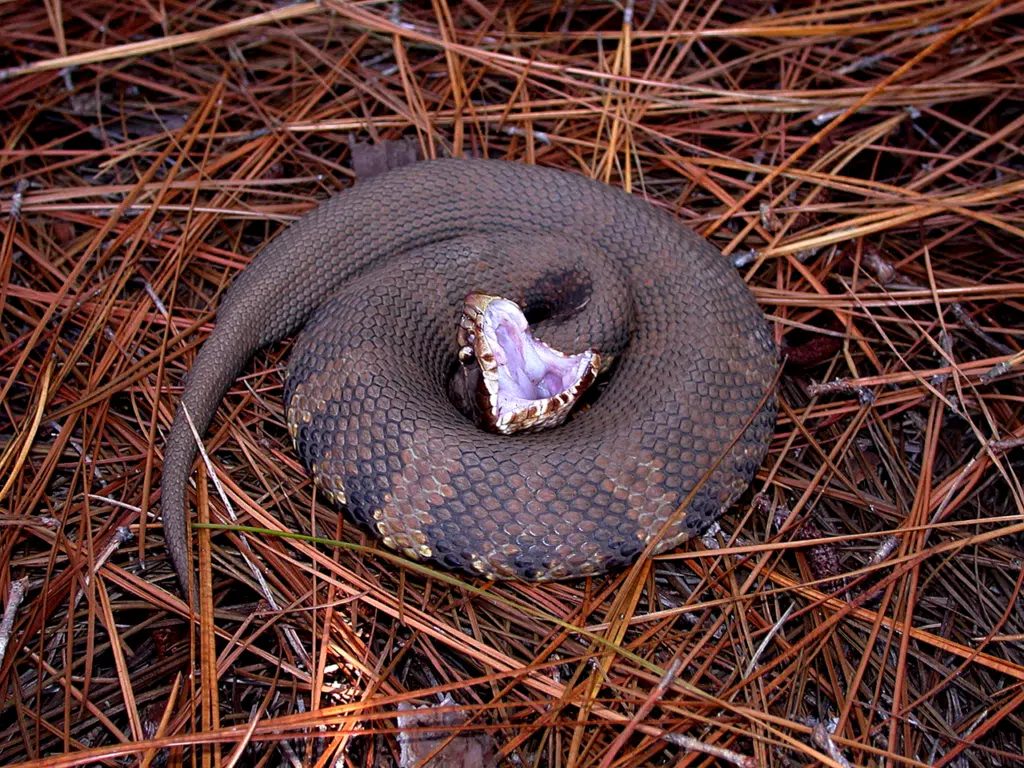
The Northern Cottonmouth (Agkistrodon piscivorus) is a pit viper and is one of the semi-aquatic vipers. These are large snakes and can deliver a potentially fatal bite. They roll their body and display their fangs when they feel threatened.
You are likely to encounter this snake near slow-moving water and shallow lakes, along with marshes and streams. They are excellent swimmers. They can grow to more than 80 centimeters in length with females being smaller than males.
This snake has a broad head with a blunt snout. They are solid black, except for facial markings. They can consist of gray, tan, olive, or brown with dark crossbands. The crossbands have black edges and a break on the dorsal mid-line.
2. Eastern Copperhead
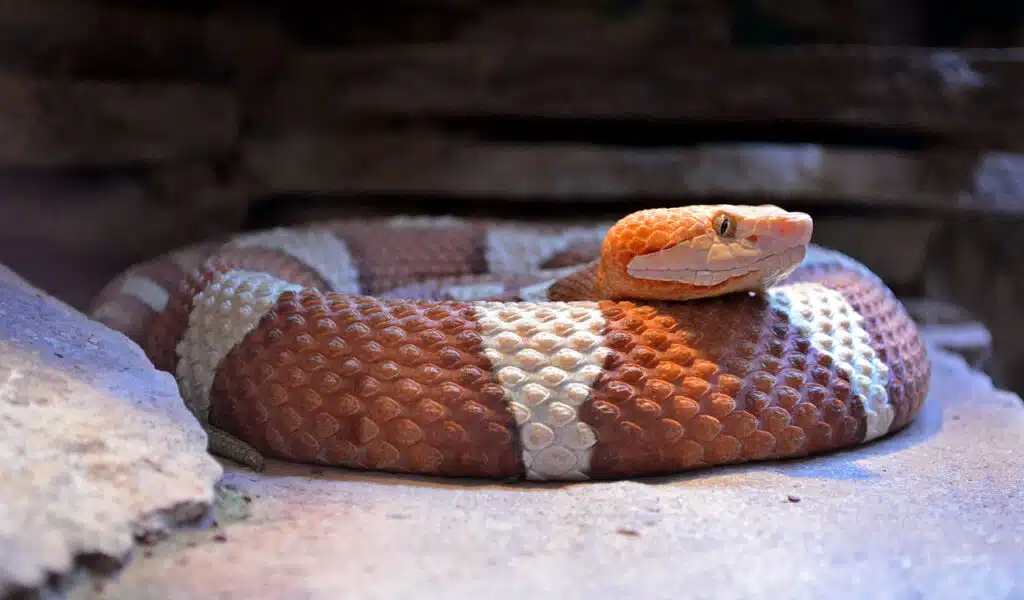
The Eastern Copperhead (Agkistrodon contortrix) is a venomous pit viper and is dark brown with hourglass-shaped markings. They are light red/brown or brown/gray. This snake has a heavy body. Juveniles are born with yellow or green tips to their tails.
As adults, they grow to 95 centimeters in length. They have broad heads with sloped snouts. They are pale tan to pink with up to eighteen crossbands. The crossbands darken at the edges. The crossbands divide at the mid-line and alternate down either side of the body.
You are likely to encounter this venomous snake in mixed woodlands, deciduous forests, rocky outcrops, and low-lying swamp areas.
3. Timber Rattlesnake
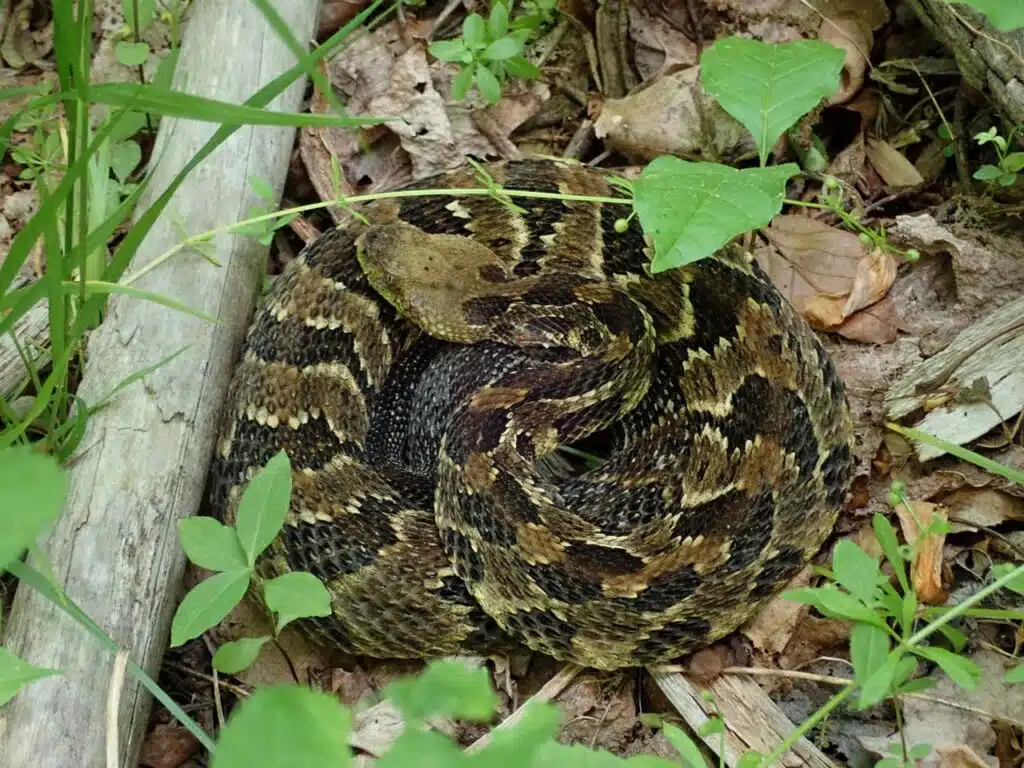
Timber Rattlesnakes (Crotalus horridus) are pit vipers with toxic bites. They can grow to 152 centimeters in total length and can weigh up to 1,500 grams. The snake has keeled dorsal scales
The snake has dark brown to black crossbands on a gray or yellow-brown base color. The crossbands have zig-zag edges, some are M or V-shaped. There is usually a rusty-colored stripe. The belly is yellow with black markings. Some of these snakes are solid black.
4. Eastern Diamondback Rattlesnake
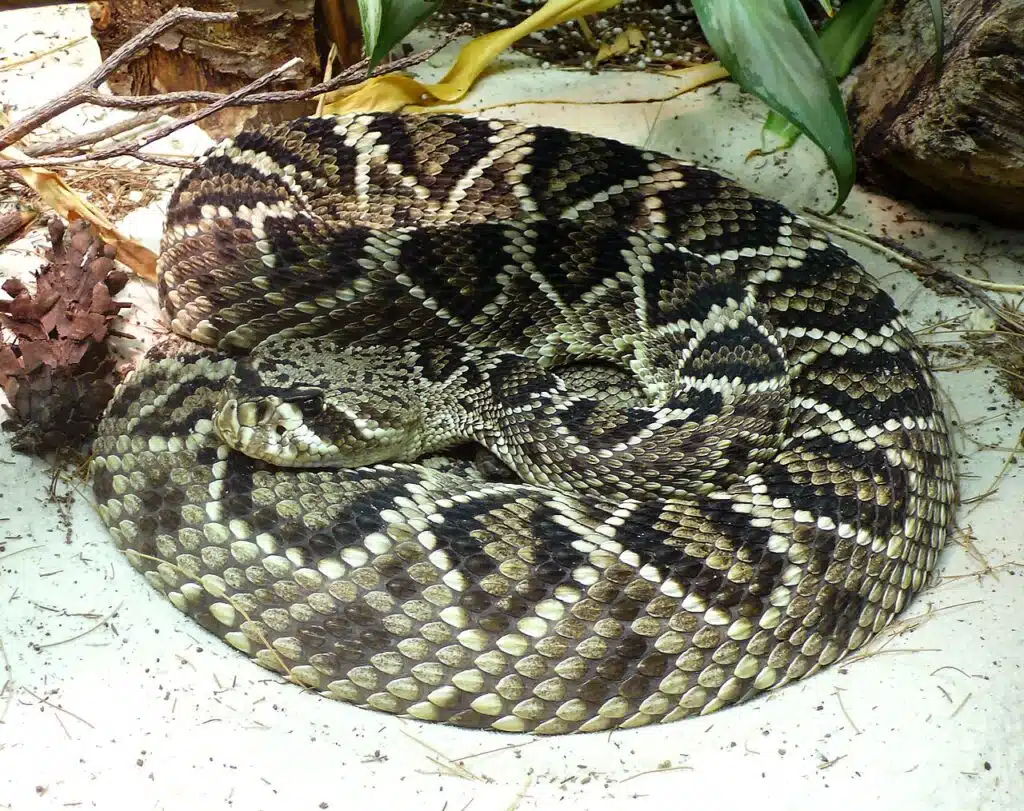
This pit viper (Crotalus adamanteus) is one of the heaviest venomous snakes in the United States. It is also the largest rattlesnake. They can grow to 2.4 meters in length and weigh more than fifteen kilograms.
The Eastern diamondback rattlesnake has a brown-yellow, brown-gray, olive, or brown color pattern with up to thirty-five black or dark brown diamonds, which are lighter in the center. Each of the diamonds is outlined by cream or yellow scales.
The diamonds turn to approximately ten bands around the tail at the rear. They have yellow or cream bellies with mottling in dark on the sides. There is a stripe that runs from the eye to the mouth.
5. Dusky Pygmy Rattlesnake
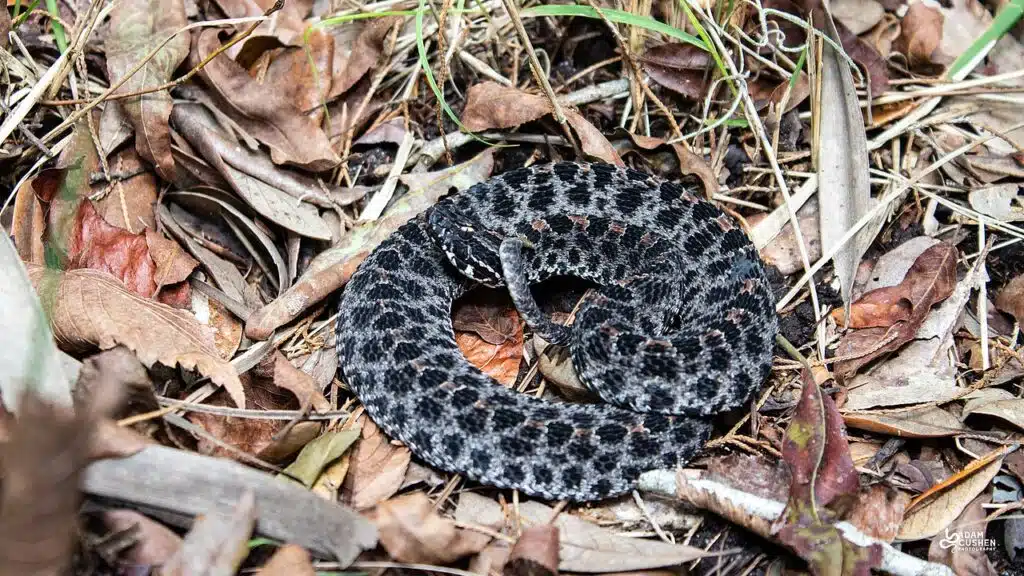
Dusky Pygmy Rattlesnake (Sistrurus miliarius barbouri) are pit vipers that grow to 76 centimeters in length. They have rounded dorsal spots with a white belly.
If bitten by one of these venomous snakes, you can experience severe pain for up to twenty-four hours, even with treatment. This snake’s venom can cause blood clots.
This small snake is thick for its size. The body color can vary from dark gray to light gray. There are charcoal patches that disrupt the brown-red stripe that runs down the center of the back. There is a slender tail with a small rattle.
6. Western Pygmy Rattlesnake
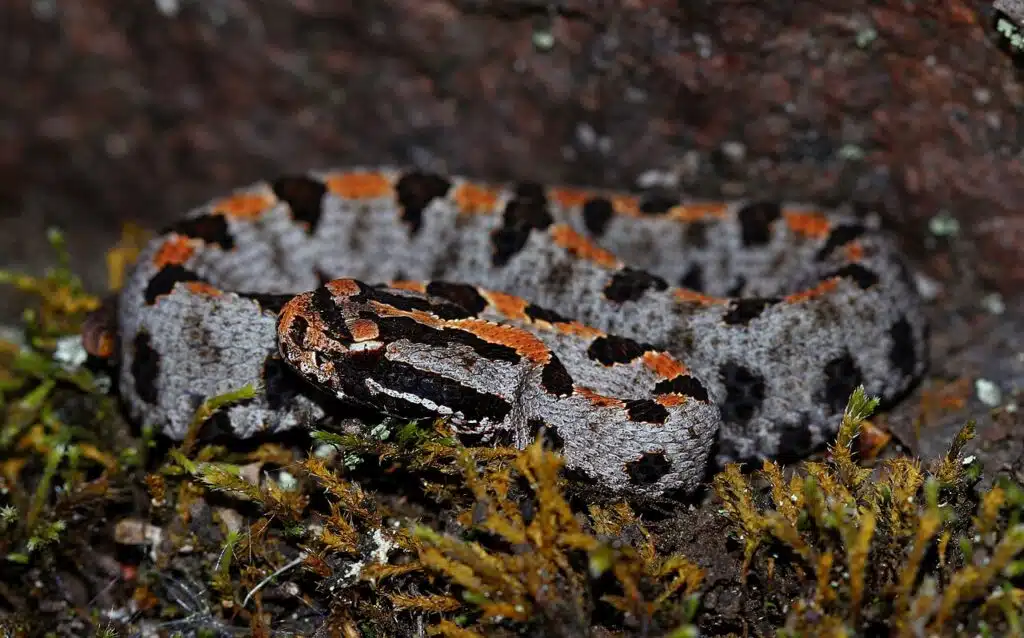
The Western Pygmy Rattlesnake (Sistrurus miliarius streckeri) is a venomous pit viper that grows to 63 centimeters in length. This venomous Mississippi snake has a distinct pattern with patches that are wider than they are long.
There are spots on the sides. The belly is cream or gray. Juveniles are similar to adults with yellow tail tips. This is a solitary snake and is seen basking in the sun. they use abandoned burrows.
The rattle is tiny and makes a buzzing noise, which is only heard from a few feet away. They can be very aggressive and will strike furiously. Some individuals do not attempt to rattle, so be sure to keep an eye out when you are in nature in Mississippi.
7. Eastern Coral Snake
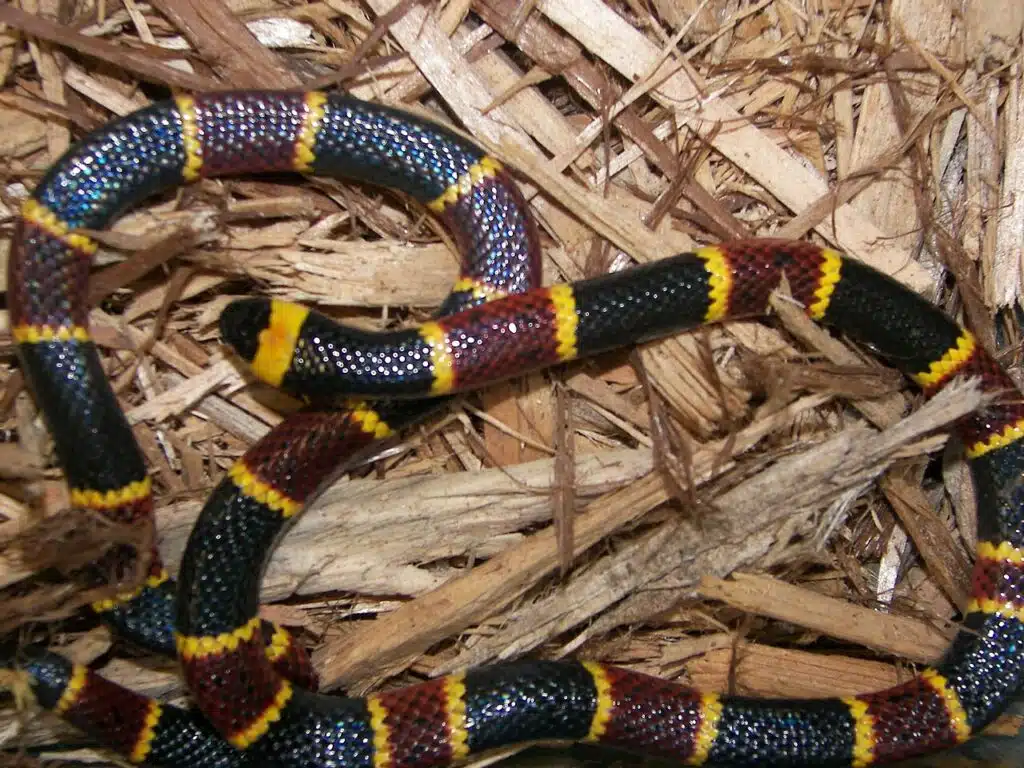
This (Micrurus fulvius) is a very venomous coral snake that can grow to 80 centimeters in length. The male has a longer tail than the female but the female has a longer overall length. It has smooth scales with a pattern of rings that go around the body.
The rings are black and red, separated by narrow yellow rings. The head is black. A children’s rhyme says “red next to black, safe from attack. Red next to yellow, you are a dead fellow,” this is a useful rhyme to teach children to identify these venomous snakes and avoid being bitten.
41 Non-venomous Snakes in Mississippi
The non-venomous snakes in Mississippi include:
1. Gray Ratsnake
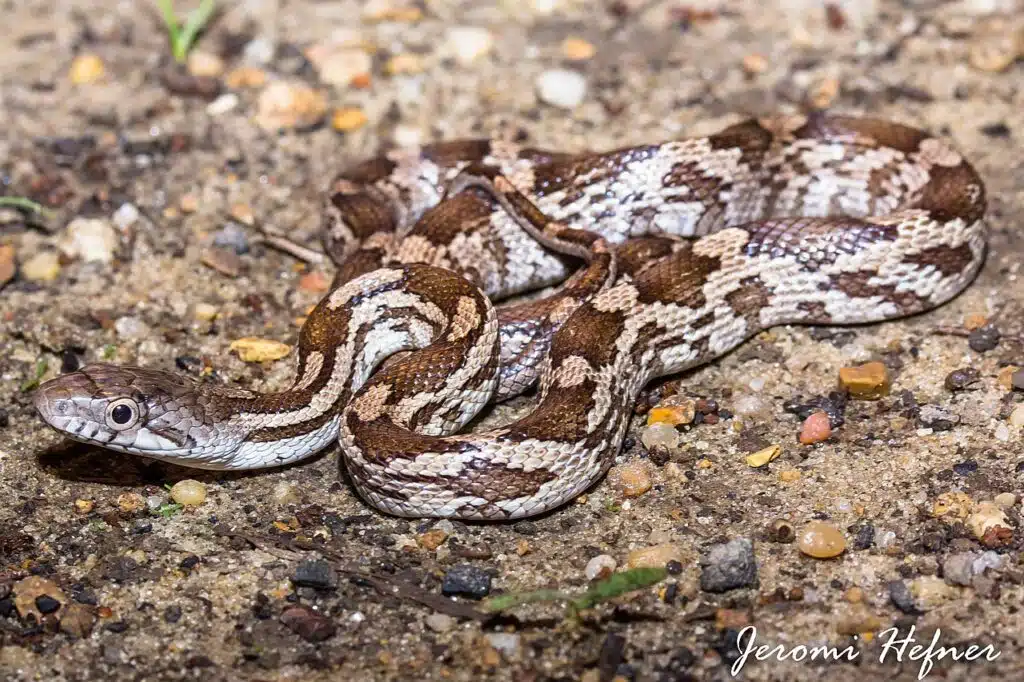
The Gray Ratsnake (Pantherophis spiloides) is a medium to large snake that can grow to 183 centimeters in length. This snake retains its juvenile pattern, which comprises dark dorsal patches separated by light gray scales. There is a solid band over the eyes.
Some species are black when they reach adulthood. The mid-body scales are weakly keeled. This snake is an excellent climber and is comfortable in trees and on the ground. They are often seen in hardwood forests, tree-lined streams, fields, barns, sheds, and cypress stands.
2. Black-masked Racer
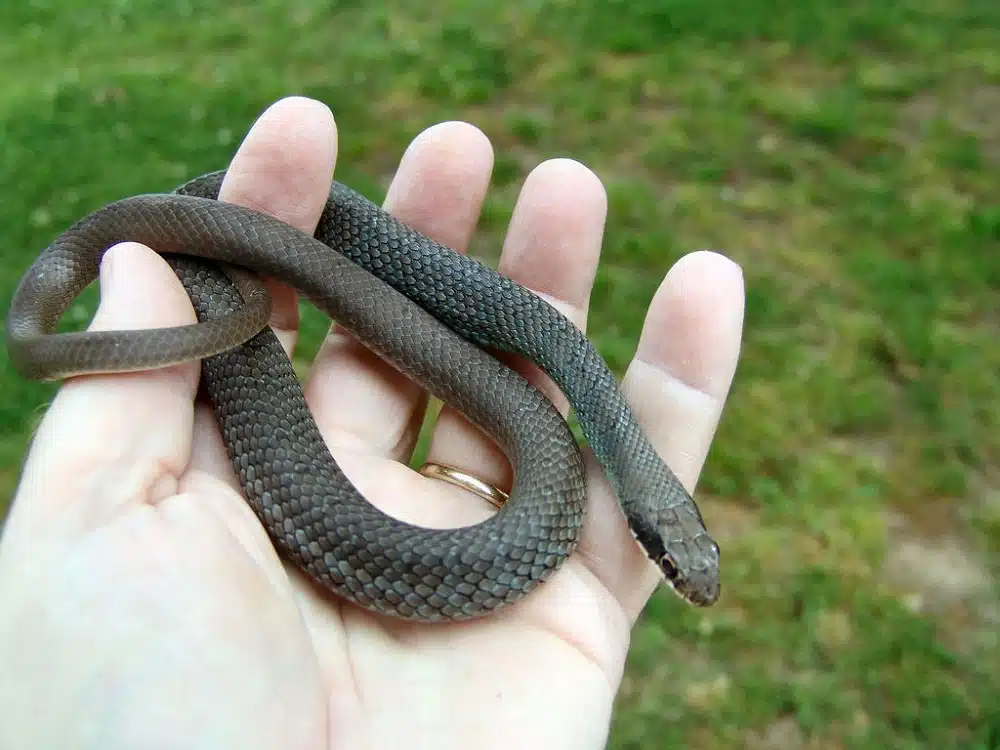
This nonvenomous snake (Coluber constrictor latrunculus) can grow to 152 centimeters in length. The pattern varies with many having a solid color. They are sometimes referred to as runners instead of racers.
They have a light belly color of yellow, tan, or white. Juveniles have distinct patterns with a row of dark patches on a light background. There is no pattern on the tail. As they age the pattern fades.
You can encounter this snake in old fields, wetland edges, and forest edges. They are also sometimes encountered in agricultural and disturbed habitats. As their name suggests, they will race off at a fast pace if disturbed, rather than facing the threat.
3. Southern Black Racer
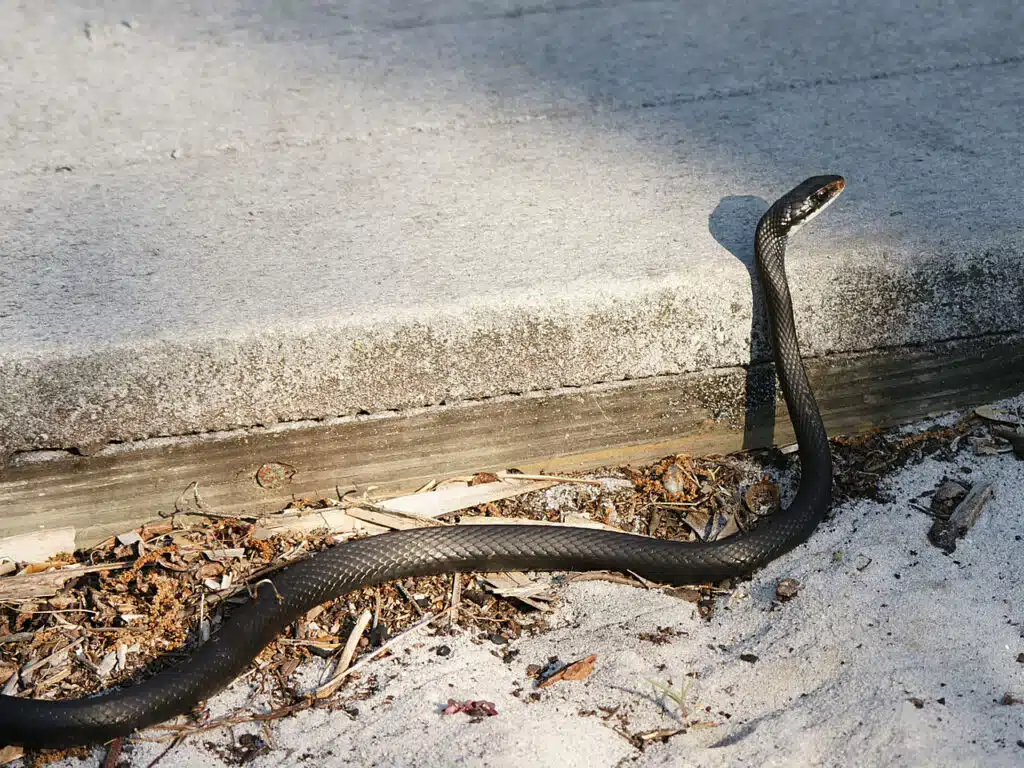
Southern Black Racers (Coluber constrictor priapus) are very common in Mississippi. Being active during the day, there is an increased chance of encountering one. They will strike and wriggle wildly if you try and handle them. Often they defecate a foul odor, which is a defense against predators.
They are thin snakes with black bodies and gray bellies. The chin is white. They are very fast and will try and escape rather than face a predator or human.
This snake can grow to 142 centimeters with the largest recorded at 180 centimeters.
4. Ribbon Snake
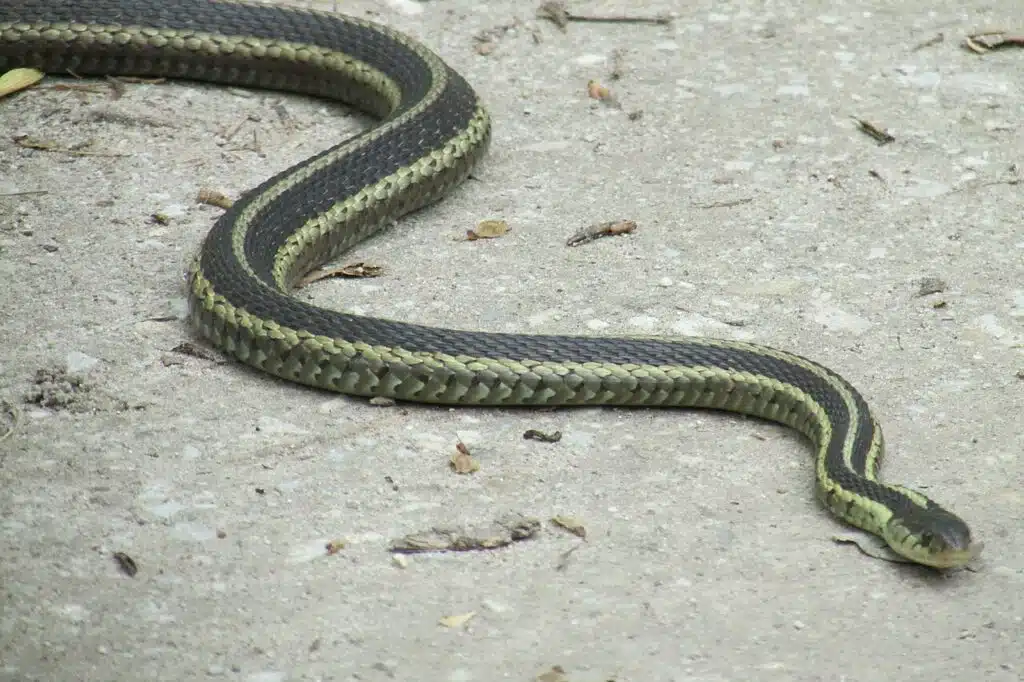
Ribbon Snakes (Thamnophis saurita) are common garter snakes encountered in Mississippi. This non-venomous snake can grow to 89 centimeters in length. They are dark brown and have yellow stripes.
Females are thicker than males. They are commonly encountered in wet climates, including streams, marshes, ponds, and lakes. They are very active from April to October and will hibernate during the cold winter months.
They are often found in high vegetation and aquatic habitats. They swim to catch their prey.
5. Speckled Kingsnake
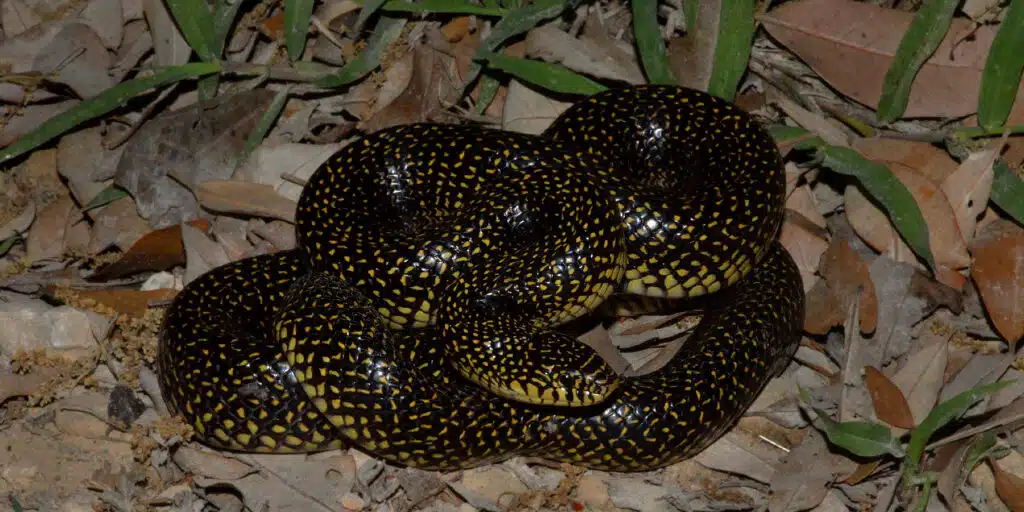
The Speckled Kingsnake (Lampropeltis holbrooki) is a non-venomous snake that grows to 120 centimeters in total length. They have a pattern of black with yellow-white specks and a speck in the middle of each dorsal scale.
This snake prefers wet habitats, including rivers and swamps. They do sometimes make their way to grassy fields and woodlands. They rattle their tail like a rattlesnake to scare predators.
When threatened they will give off a foul odor or bite. They are docile snakes and will only strike once or twice if captured. They are common pets and are often captive-bred.
6. Dekay’s Brownsnake
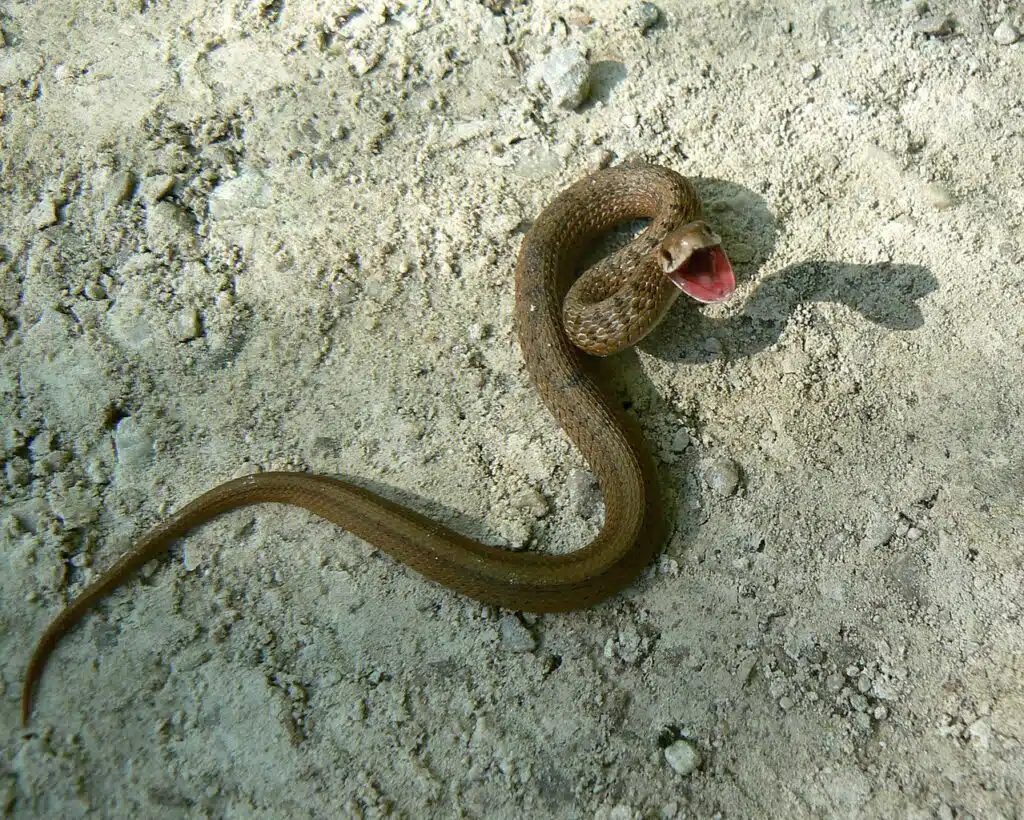
The Dekay’s Brownsnake (Storeria dekayi), also known as the brown snake, is a small snake, completely non-venomous, and only grows to 30 centimeters in length. This is a brown or gray snake with a center stripe with black spots.
They can be found in a variety of habitats, including wet meadows, residential areas, and riparian woodlands. They choose areas that are moist with plenty of organic material.
The brown snake will very rarely bite. If they are threatened, they tend to flatten their body, making them look larger and placing them in an aggressive pose. They will cover you in foul odor if you try and handle them.
7. Rough Greensnake
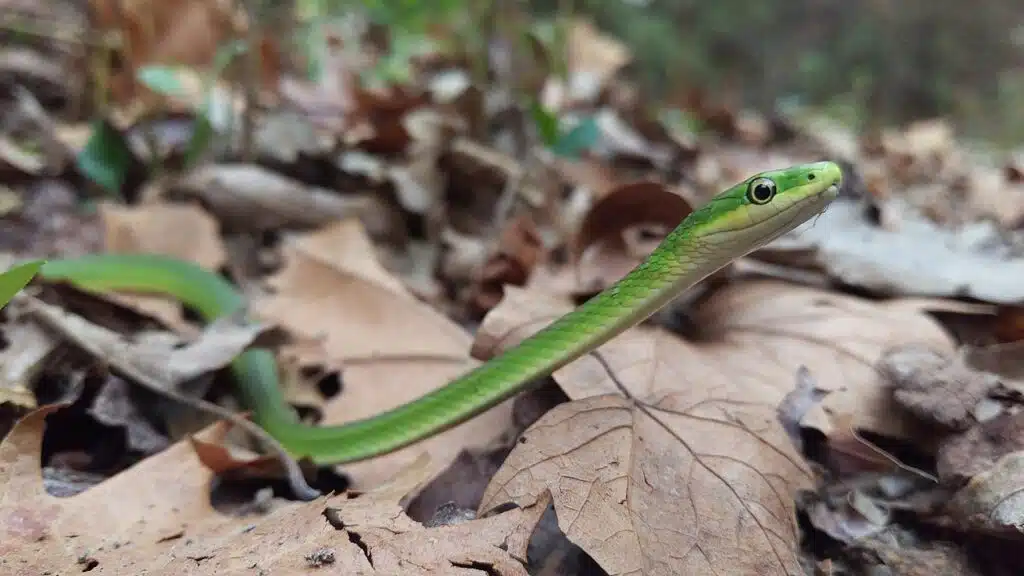
The Rough Greensnake (Opheodrys aestivus) is a non-venomous snake, also known as the green grass snake. They are very docile and will allow you to approach them without biting. If they do bite, they are harmless and do not have venom.
This bright green snake has a yellow belly. Its coloration helps it blend into green vegetation, making it hard to see. They have keeled dorsal scales and can grow to 116 centimeters in total length.
You may encounter this docile and non-venomous snake in woodlands and meadows. They are never far from water and are excellent climbers. They are also good swimmers.
They are active during the day and coil themselves in branches at night.
8. Broad-banded Watersnake
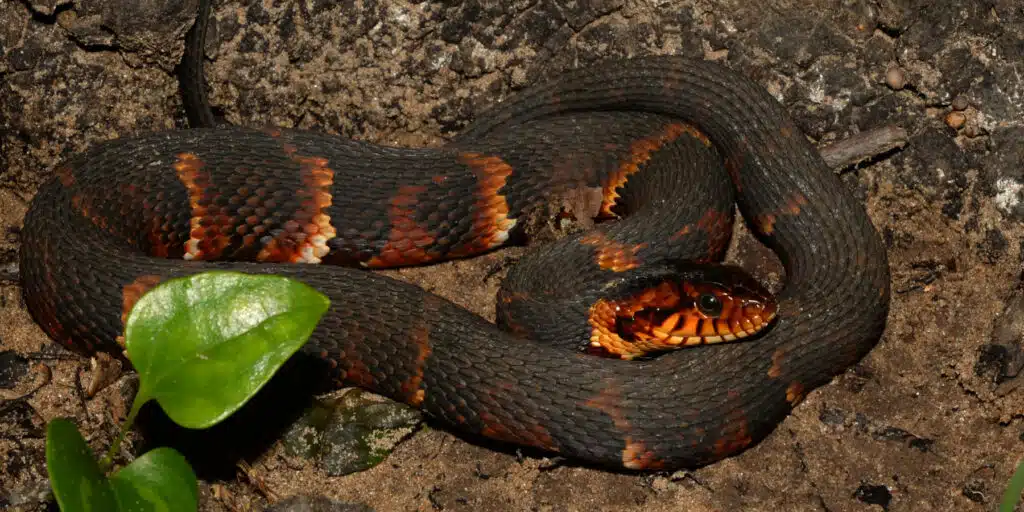
The Broad-banded Watersnake (Nerodia fasciata confluens) is an aquatic non-venomous snake that can grow to 107cm in length. As adults, they can weigh up to 464 grams.
This snake can be gray, brown, or green-gray with dark crossbands. Some are dark with their pattern being barely visible. The belly is white or off-white. The head is flat and the body is heavy.
They have a dark stripe from the eye to the jaw. If you threaten them, they release a foul odor. They are often confused with the venomous cottonmouth, as they are often found in the same habitat.
9. Southern Banded Watersnake
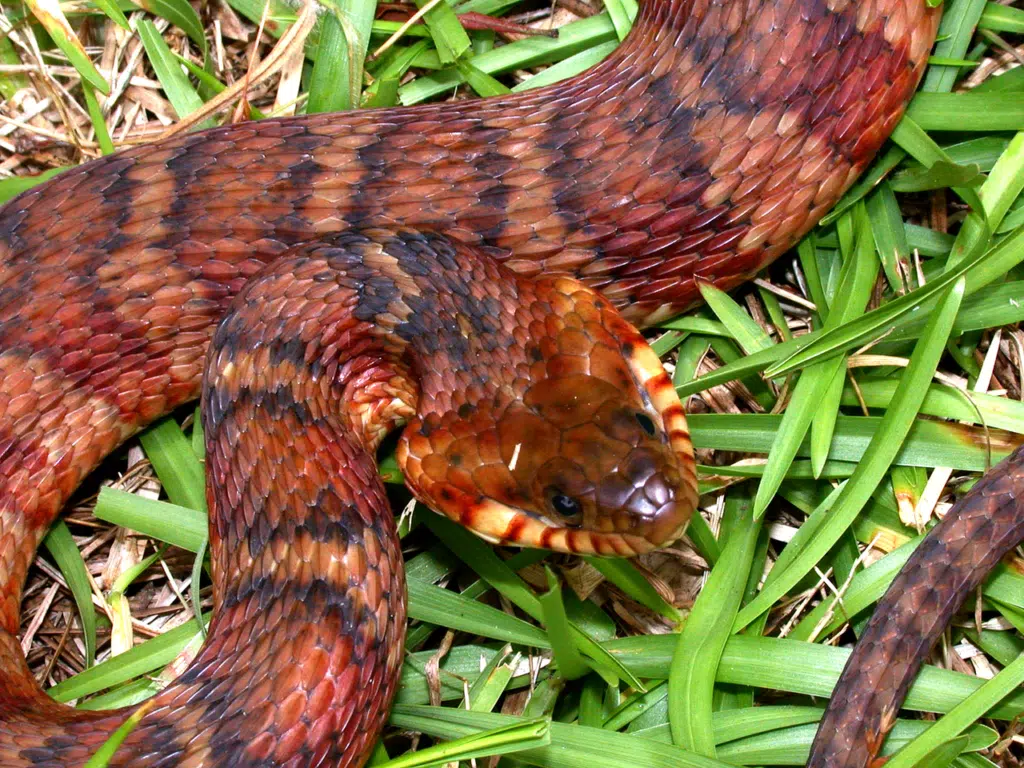
The Southern Banded Watersnake (Nerodia fasciata fasciata) can grow to 107 centimeters in length. It has a stout body with a broad black, brown, or red crossband pattern that runs down the back. There are light narrow bands in red, gray, or tan.
The light bands are broken by a stripe that runs down the center of the back. The crossbands fade as the snake darkens as they get older. Sometimes older snakes are solid black. The background color can vary from tan, red, yellow, or gray. There is a dark stripe from the eye to the jaw.
This snake is non-venomous and poses no threat to humans or pets. They will bite as defense, though they are not aggressive and will do everything they can to avoid contact with humans. Bites usually only occur when the snake is roughly handled.
10. Plain-bellied Watersnake
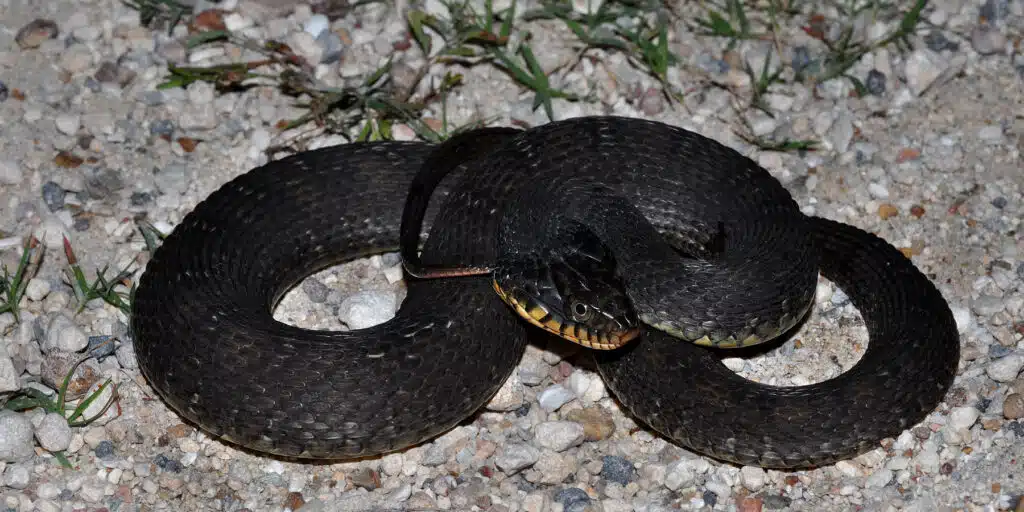
The Plain-bellied Watersnake (Nerodia erythrogaster) is commonly encountered in aquatic habitats in Mississippi. This large snake has a thick body and is a solid color. They can be black, green-gray, olive green, gray, or brown. Some are lighter in color with dark patches.
You can tell the plain-bellied watersnake apart from other watersnakes by its unmarked belly which will be yellow or red. This snake can grow to 122 centimeters in length.
As juveniles, they have a banding pattern, similar to the banded watersnake but have an unmarked belly. They are always found near a permanent water source. Often encountered in lakes, ponds, floodplains, and rivers.
11. Common Garter Snake
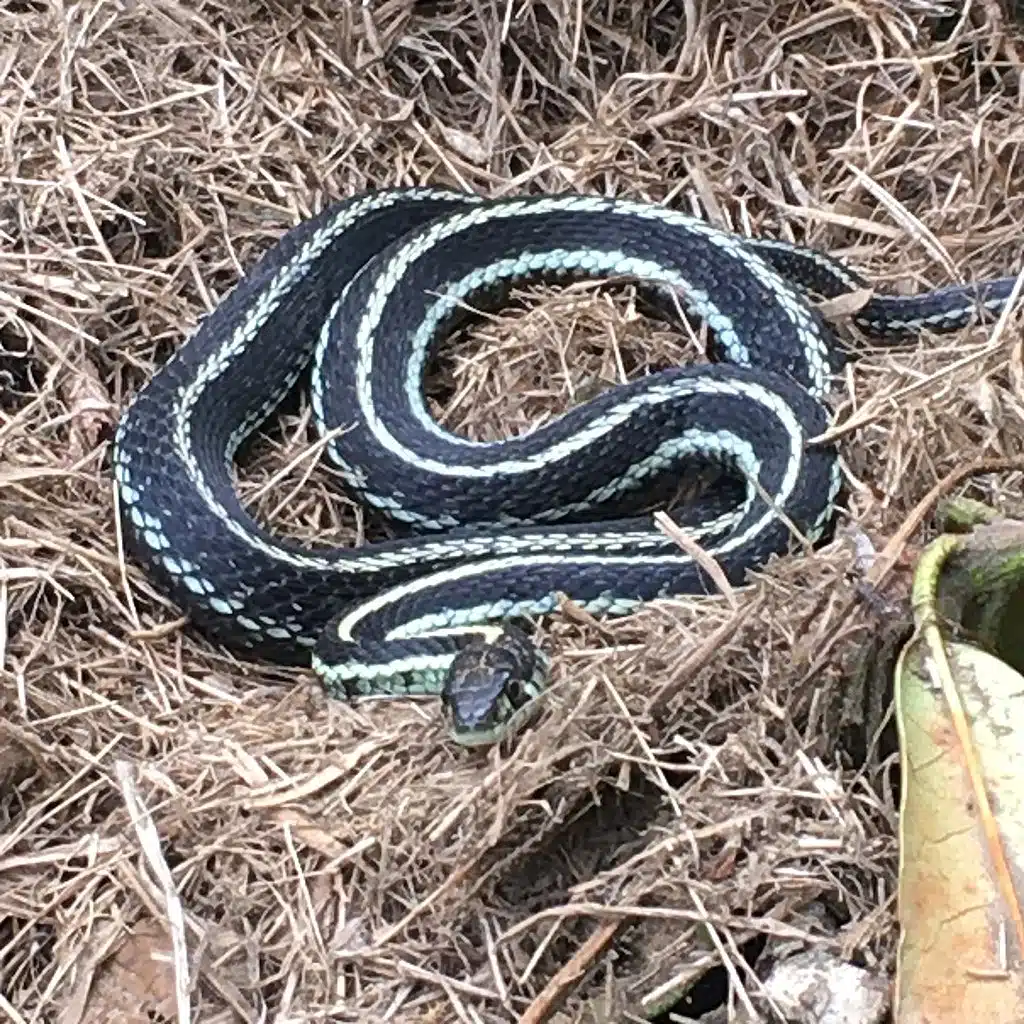
The Common Garter Snake (Thamnophis sirtalis) is indigenous to North America and is easily identified with a pattern of yellow stripes on a brown, green, or black background. This snake can grow to 137 centimeters in length and weigh up to one hundred and fifty grams.
They often have stripes of a range of colors, they also vary in color from green or blue, to gold, orange, red, black, or brown. They are commonly found in fields, prairies, forests, wetlands, marshes, meadows, and ponds. They are never too far from water.
12. Ring-necked Snake
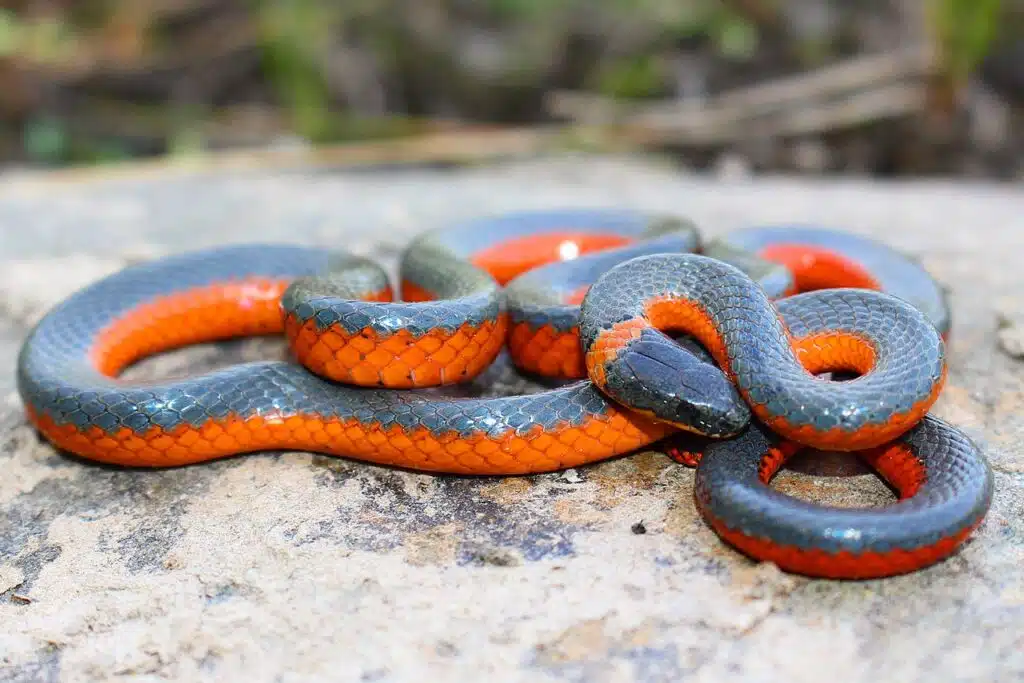
The harmless Ring-necked Snake (Diadophis punctatus) is very secretive and nocturnal. You will very rarely encounter this snake, even though it is very common throughout Mississippi. They have a unique defense posture which includes curling the tail, exposing the red-orange posterior, and showing their ventral surface when they feel threatened.
These snakes are brown, blue-gray, black, or olive with a red, yellow, or yellow-orange neckband. The head is darker than the body. The belly is yellow-orange with crescent-shaped spots on the margin.
This snake can grow to 38 centimeters in length. They have smooth scales. They are found in a variety of habitats, usually with abundant cover. You may encounter them in rocky hillsides or open woodlands. They are sometimes found in moist habitats where they prefer moist soil. They stay away from human structures, though they may use urban areas to hide from predators.
13. Diamondback Watersnake
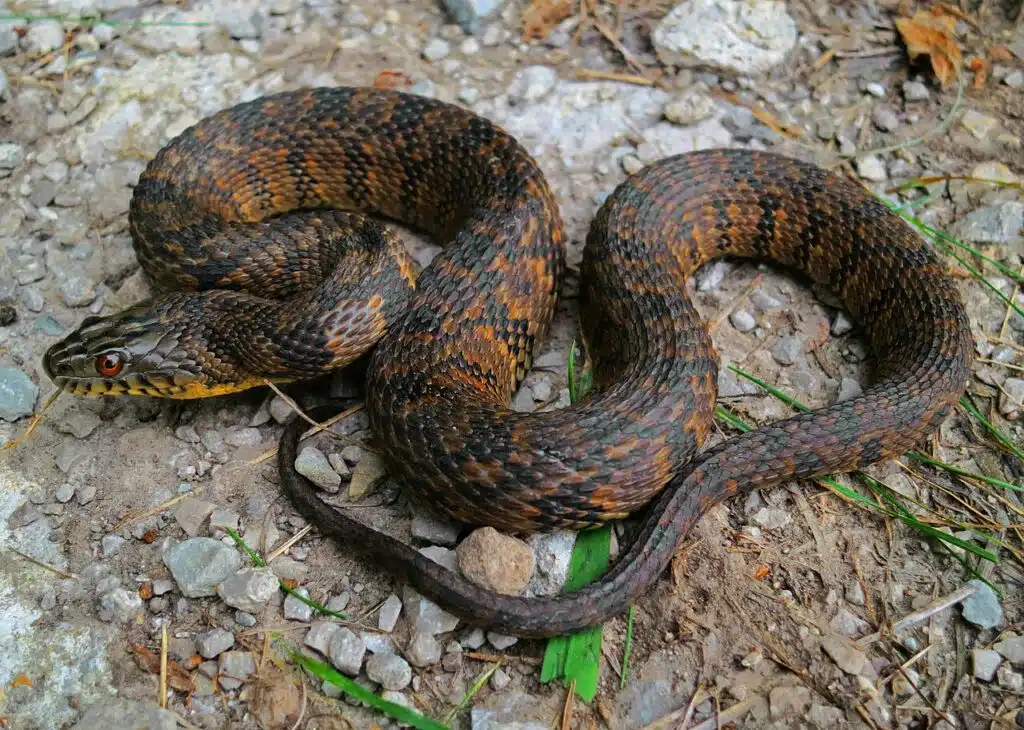
The Diamondback Watersnake (Nerodia rhombifer) is a non-venomous snake, endemic to the United States. This snake can vary from brown to dark brown, or olive green with a net pattern on the back in black. Each spot looks similar to a diamond.
There are dark bars and light colors down the side. The belly is light brown or yellow with black patches. This is a heavily-keeled snake with a rough texture. The diamondback watersnake can grow to 122 centimeters in length.
As juveniles, they are light in color with a pronounced pattern, darkening with age. This is a very common watersnake and is found near slow-moving water, including rivers, swamps, ponds, and streams.
14. Corn Snake
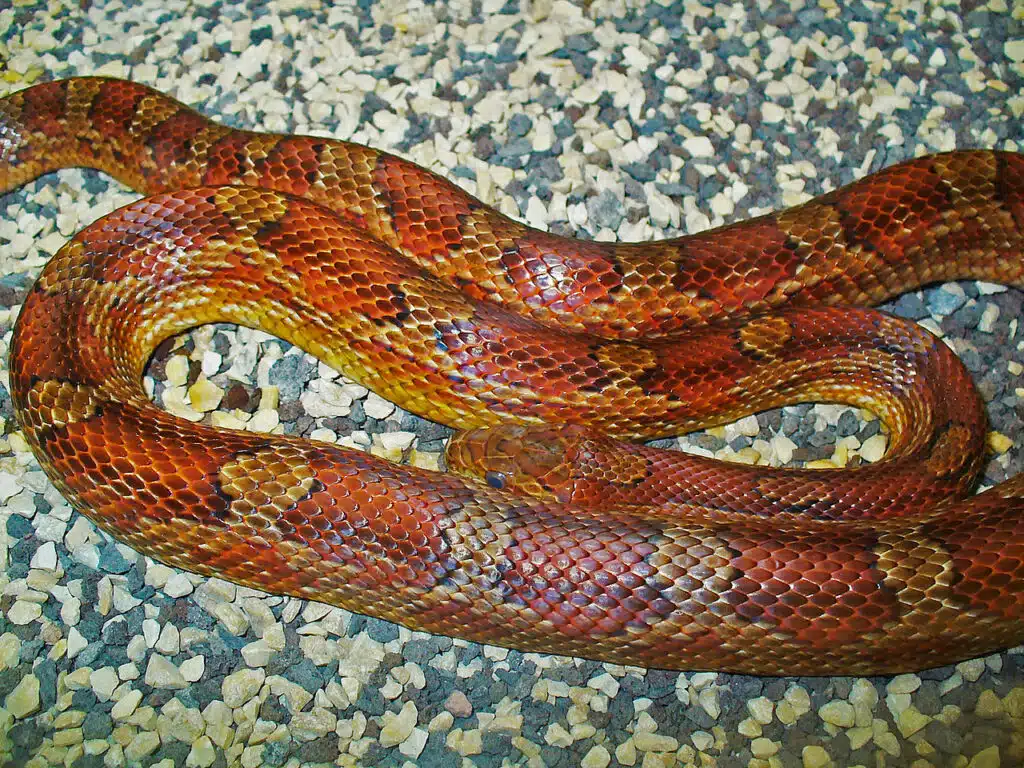
The Corn Snake (Pantherophis guttatus) is one of the most popular snakes to be kept as a pet. This non-venomous snake is found in Mississippi and resembles the venomous copperhead. They are often encountered near grain stores, where they prey on rodents.
It has a neat checkered pattern on the belly, resembling corn kernels. This is a large snake, growing to 182 centimeters in length. They have a fifteen-year lifespan in the wild but are known to live to more than twenty in captivity.
The corn snake is brighter than the copperhead. They are also slender in build, do not have heat-sensing pits, and have round pupils.
15. Common Watersnake
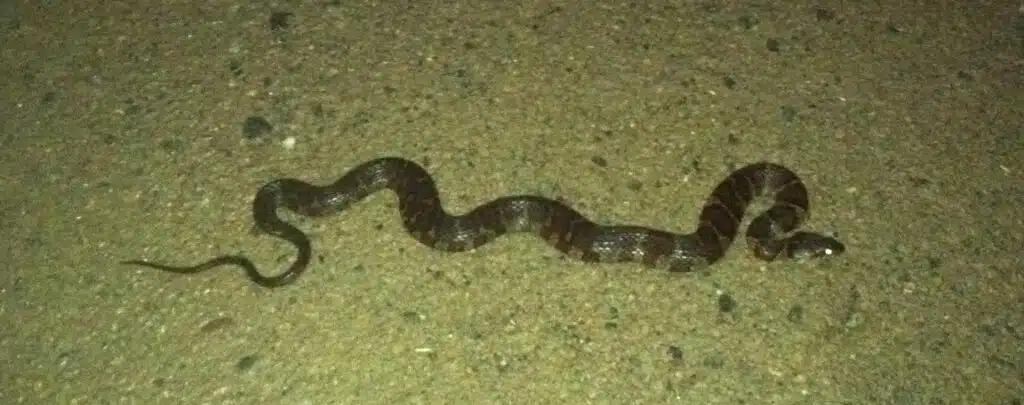
Common Watersnakes (Nerodia sipedon) are large non-venomous snakes, native to North America. They are often confused with the venomous cottonmouth. This snake can grow to 135 centimeters in length.
This snake can vary in color from brown to red or gray to brown-black. There are crossbands on the neck and dark patches on the body. As the snake ages, the color darkens and the patterns are less visible. Some individuals become completely black as they age.
The snake’s belly also varies in color and can be yellow, gray, or white with red or black crescents. It is completely harmless to humans and is often killed because it is mistaken as the venomous cottonmouth.
16. Rough Earthsnake
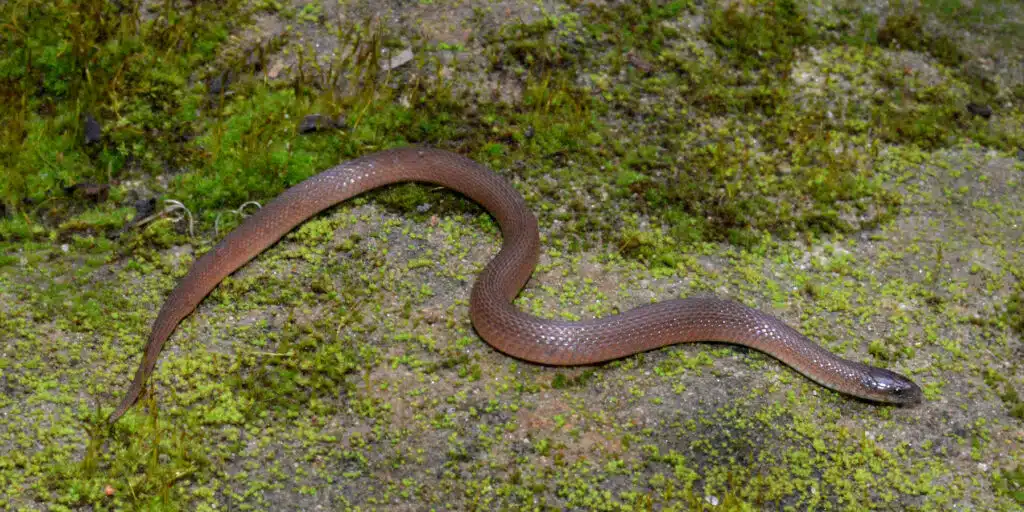
The harmless Rough Earthsnake (Haldea striatula) is secretive, small, and slender. They only grow to twenty-five centimeters in length and have round pupils, weakly keeled scales, and a divided anal plate.
This snake is a solid gray, red, or brown. As juveniles, they have a light band on the neck, which fades as they age. They have tan bellies.
This snake prefers hiding under rocks, stones, logs, and leaf litter. They are found in several forested habitats where there is ample ground cover. They also make their way into urban areas, hiding in parks, vacant lots, and gardens.
17. Mudsnake
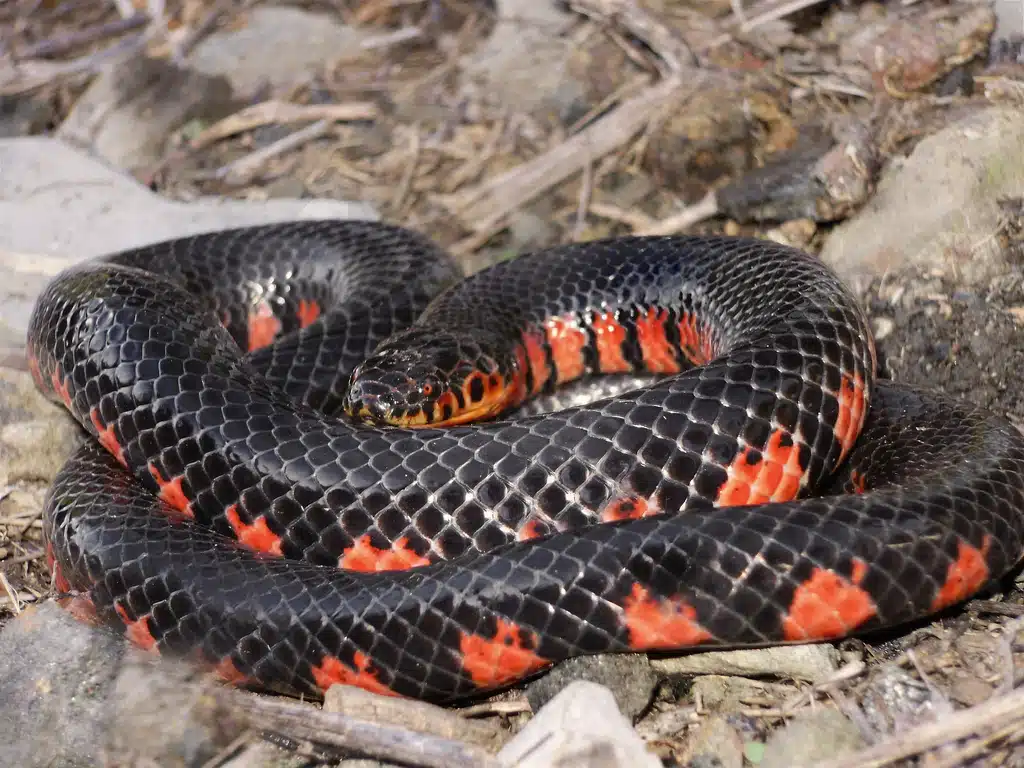
Mudsnakes (Farancia abacura) are non-venomous and semi-aquatic. They can grow to 1.4 meters in length with females being larger than males. This glossy black snake has a red and black belly. The red extends up the sides of the snake, forming bars of pink and red.
This is a heavy-bodied snake with a distinctive head. The scales are smooth. They are often encountered on stream edges, cypress swamps, in dense vegetation, or under debris. They use moist conditions to burrow into mud.
They seldom leave the water, except to hibernate or lay eggs. They are comfortable in both brackish and fresh water.
18. Florida Redbelly Snake
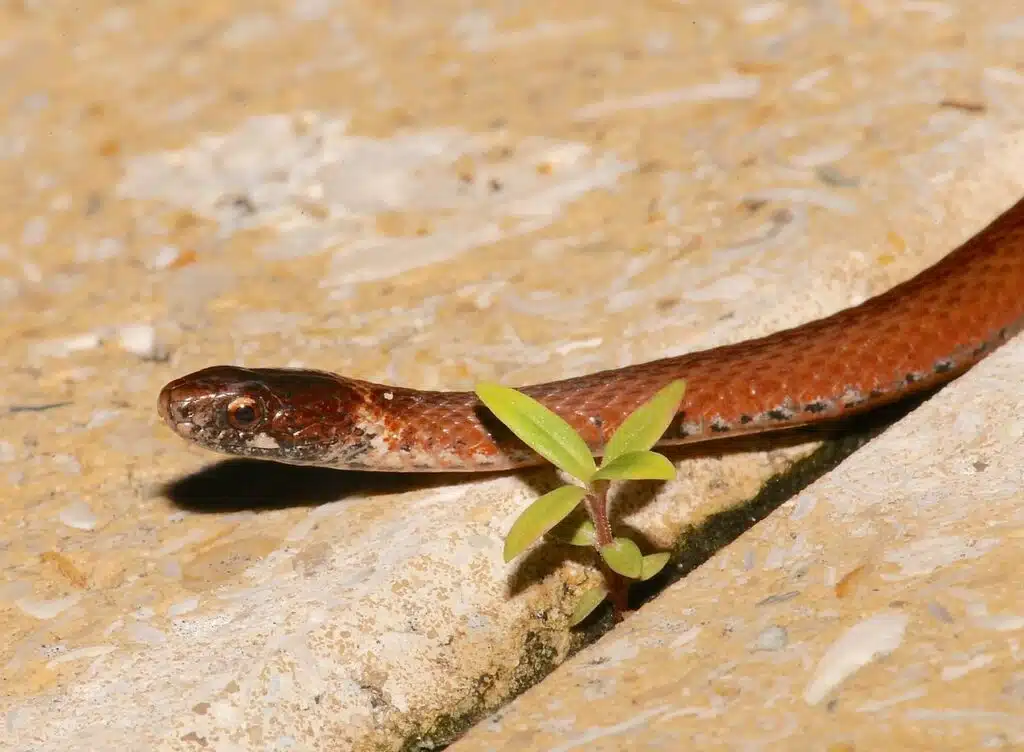
The Florida Redbelly Snake (Storeria occipitomaculata obscura) is found in marshes, swamps, ponds, and pine lands. They can grow to sixteen inches in length and are similar to ring-necked snakes. They have a red belly with a ring around the neck.
This is a very secretive snake. They are tan with a red-orange or yellow belly. There are sometimes three spots on the nape of the neck, forming a collar. The snake is known to flatten the head and body, forming a loose coil when startled. As juveniles, they have similar coloration to adults, but darker.
19. Northern Redbelly Snake
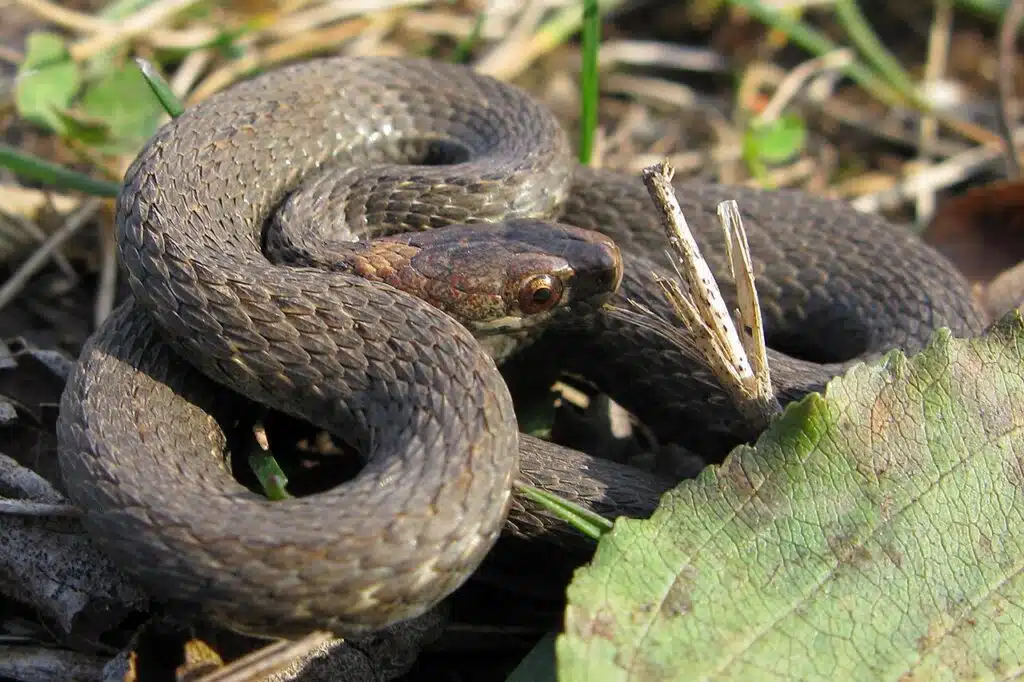
The non-venomous Northern Redbelly Snake (Storeria occipitomaculata occipitomaculata) is sometimes called the fire snake. They are solid tan-brown, olive-brown, chestnut-brown, gray, black, or gray-brown. There are three yellow spots near the head. The belly is coral or brick-red.
This snake can grow to 31 centimeters and is found in moist gardens, woodlands, and flowerbeds. They are secretive and will not confront you if they feel they are in danger, preferring to hide under rocks or logs close to forests or woods.
20. Saltmarsh Snake
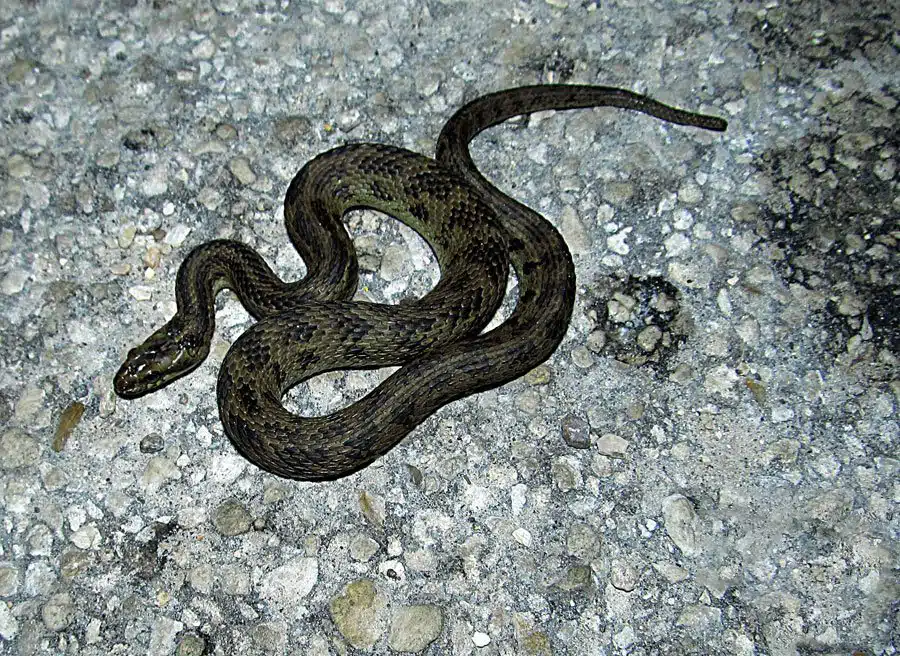
The Saltmarsh Snake (Nerodia clarkii) is semi-aquatic and non-venomous and found in brackish salt marshes. They can grow to 76 centimeters in length and vary in color and pattern. Some are gray, yellow, or tan with brown to black stripes.
Others are a variety of colors including green, tan, or gray with dark banding, while others are solid orange-red or straw-yellow. This snake prefers coastal salt marshes and mangrove swamps. They are often encountered in shallow tidal pools and creeks.
This is not a dangerous snake, but they will bite if they feel they need to defend themselves. It is very secretive and docile, they will avoid direct contact, and bites only occur when the snake is roughly handled.
21. Western Ribbon Snake
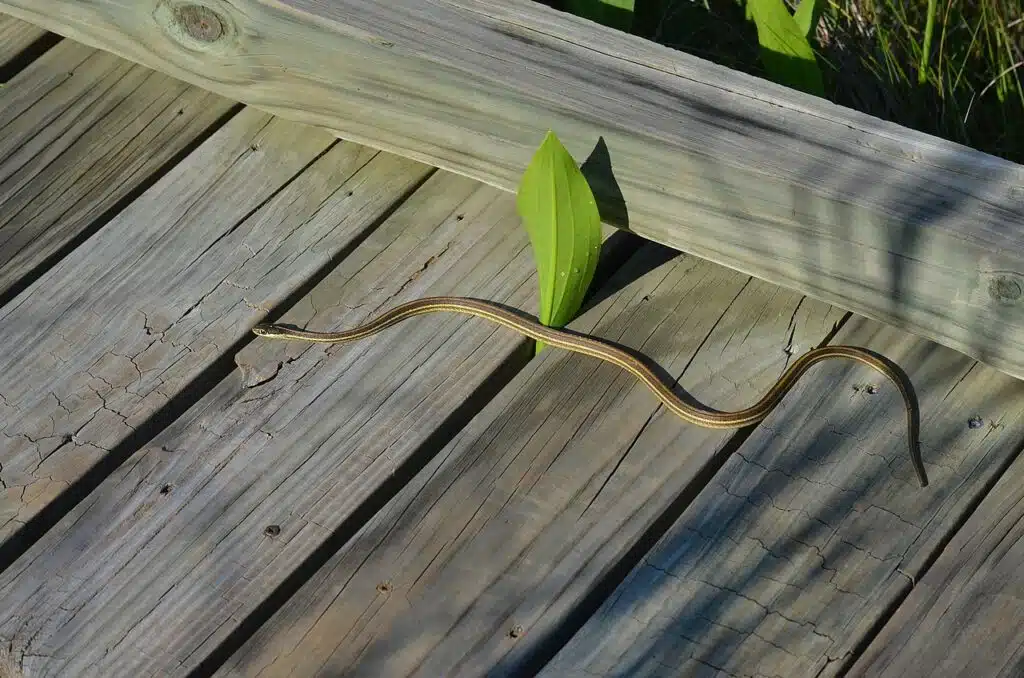
The Western Ribbon Snake (Thamnophis proximus) is a garter snake. It is slender with a long tail. They are brown, black, or olive with three stripes. The belly is yellow-white or green-white. This snake can grow to 127 centimeters in length.
This snake is often encountered near wells, adjacent to wetlands, and along rivers. They are nocturnal and secretive.
22. Eastern Hognose Snake
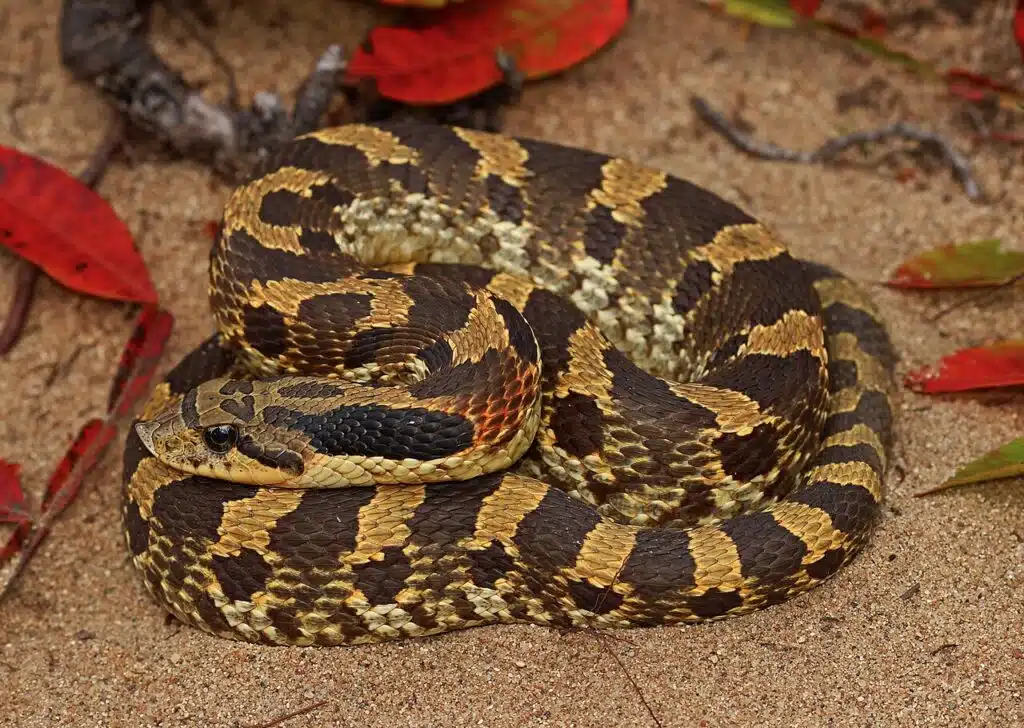
The Eastern Hognose Snake (Heterodon platirhinos) is known as the spreading adder. It is a rear-fanged non-venomous snake that can grow to over 110 centimeters in length. They are easily identified by the upturned snout that they use for digging in the soil.
The color pattern varies considerably and can be green, brown, red, orange, black, or gray. Sometimes they are a combination of these colors. They may have a checkered, patchy pattern or they could be completely patternless.
The belly is a solid cream, yellow, or gray. The underside of the tail is lighter than the underside of the belly. They are usually encountered in old fields, forest edges, and sandy pine forests.
23. Southern Hognosed Snake
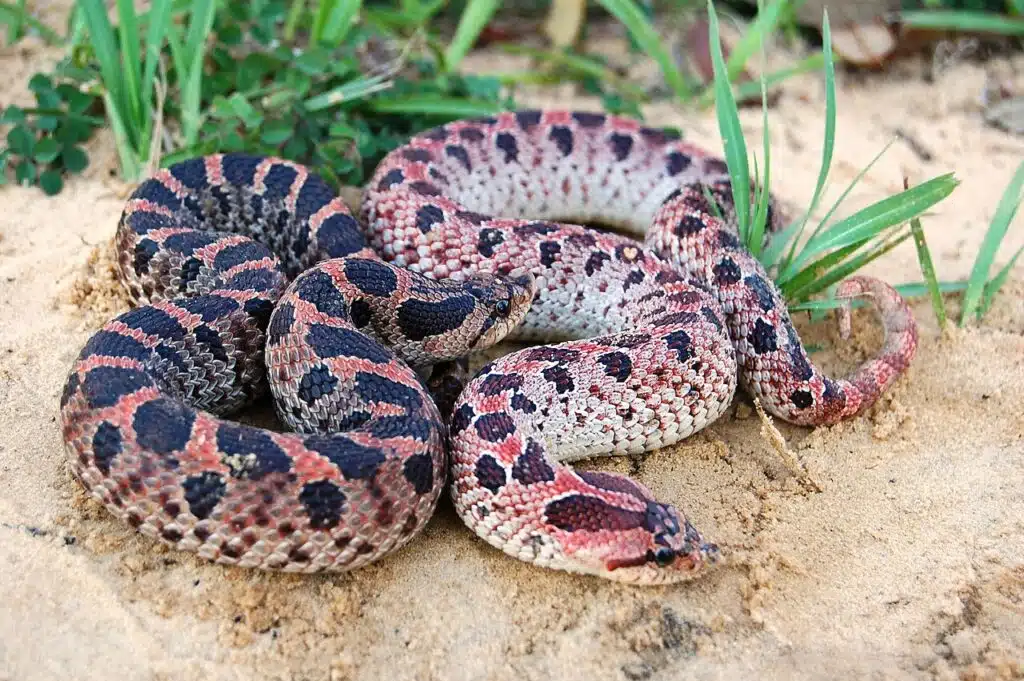
This harmless snake (Heterodon simus) can grow to 61 centimeters in length. They are stout with wide necks and upturned snouts. The scales are keeled, giving them a rough texture. The colors can include yellow, red, gray, or light brown with a row of dark patches that alternate with small patches on the flank.
The belly is darker than the underside of the tail. This snake prefers open and dry sandy areas, fields, Flatwoods, and dry river floodplains.
If you find yourself face to face with this snake it will put on a threatening display of hissing and spreading the skin on its neck and head to try and mimic a cobra. They may even pretend to strike. If this doesn’t work, it will play dead, rolling on its back and opening its mouth.
24. Black Kingsnake
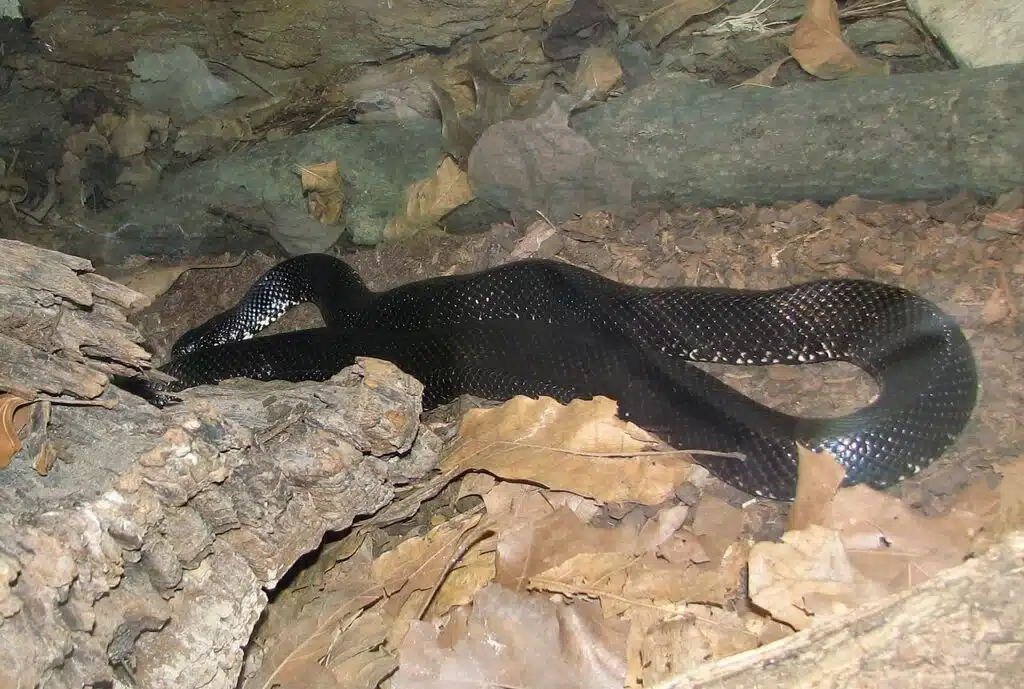
Black Kingsnakes (Lampropeltis nigra) are large constrictors growing to 122 centimeters. This black snake has spaced yellow or cream specks, which are larger and numerous on the sides. The body is unpatterned, though some do have crossbands.
The belly is checked black and yellow. This snake lives in several habitats and is one of the most frequently encountered snakes. They are found in debris piles, abandoned farmlands, and thick brush along swamps and streams.
If the snake feels threatened it gives off an unpleasant odor and shakes its tail, trying to mimic a rattlesnake. It will bite if you corner it or roughly handle it, though the bite is not poisonous.
25. Pine Woods Littersnake
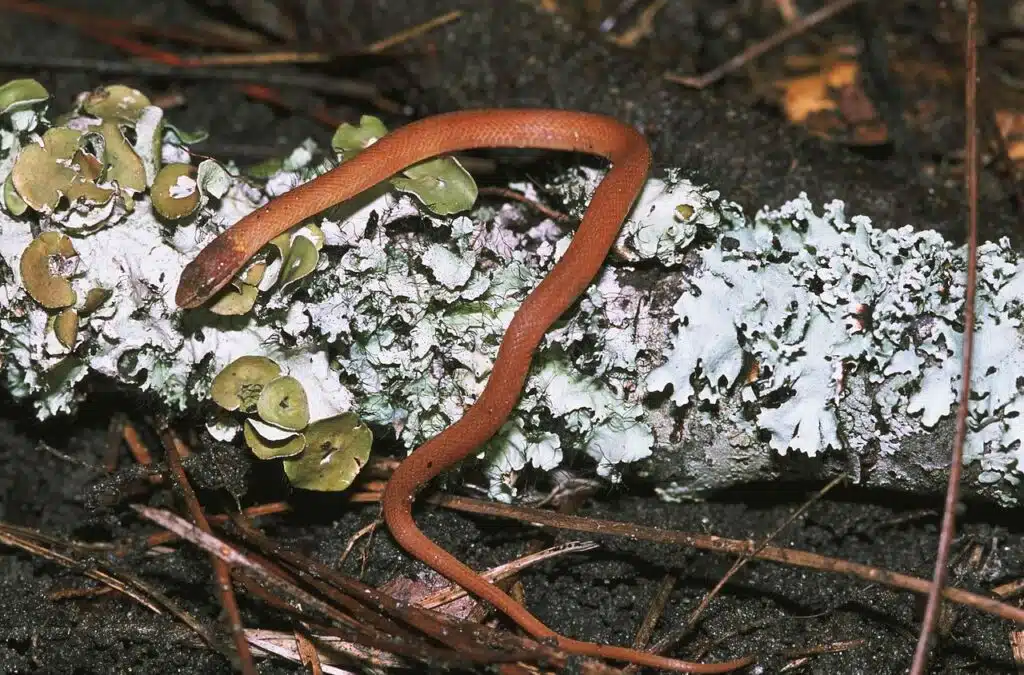
This secretive snake (Rhadinaea flavilata) is rear-fanged and non-venomous to humans. They are red-brown or yellow-brown and small in size. The snake has an unmarked belly. There is a dark strip that runs through the eye.
Often there is a lighter-colored strip down the center of the back. They have pale yellow or white lips, which is why it’s often called the yellow-lipped snake. It can grow to thirty-three centimeters in total length.
This snake inhabits mixed-pine and pine-hardwood forests and is often encountered in dark woodlands, under rotten logs, or bark.
26. Smooth Earthsnake
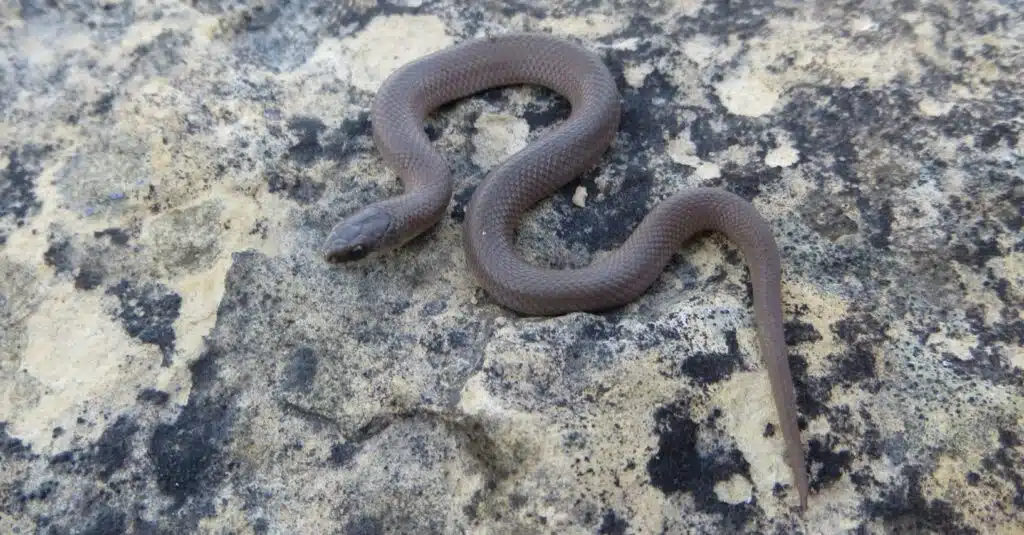
This non-venomous snake (Virginia valeriae) can be brown, deep-brown, or light brown. The first row of scales is colored, usually pale gray, pale pink, or pale fawn. The top of the head is brown with dark spots.
There is a small black ring present around the eyes. Some individuals have a light median line. This is a small snake that only grows to 25 centimeters in length.
They spend their time buried in leaf litter or loose soil and are seldom encountered by humans. They are very docile and secretive.
27. Scarletsnake
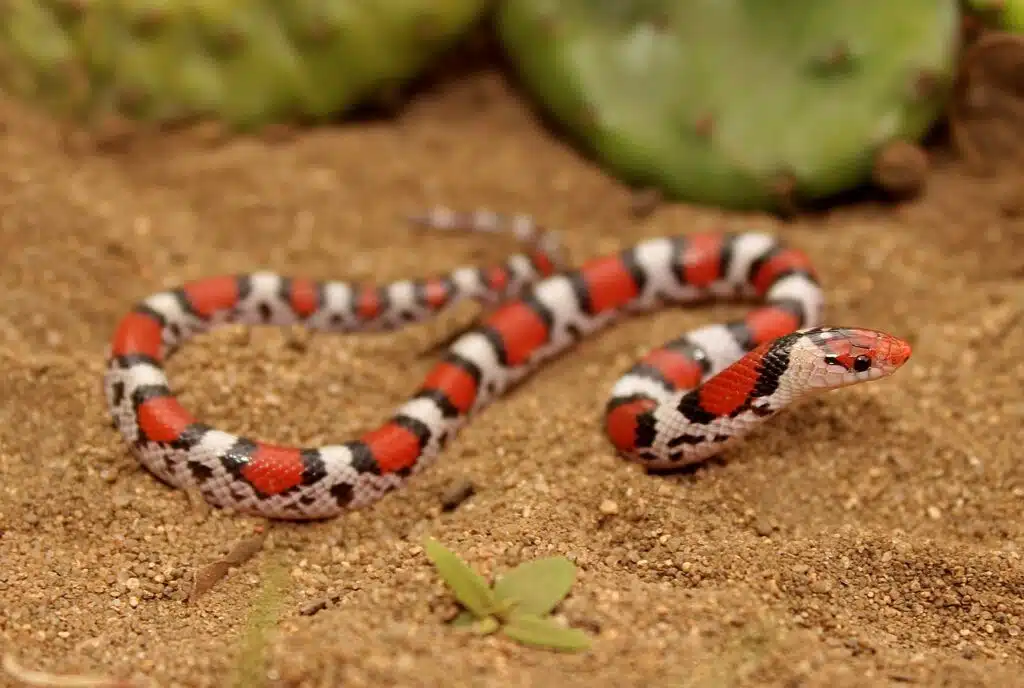
The non-venomous Scarletsnake (Cemophora coccinea) belongs to the Colubridae family and can grow to sixty-six centimeters in length. They are light gray with black-bordered white, red, or yellow patches on the back.
The belly is solid white or light gray. The patches on the back can extend to the sides, looking similar to banding. This is a secretive nocturnal snake. It may be encountered during the day in summer.
They are often found under pine debris, organic litter, or under logs.
28. Mississippi Green Watersnake
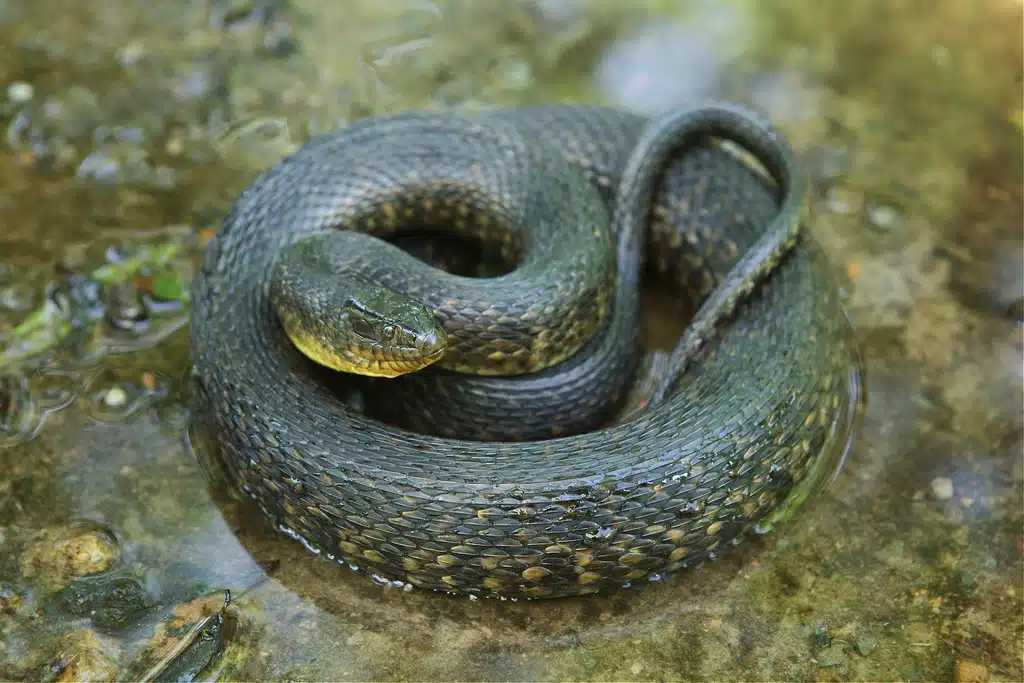
The Mississippi Green Watersnake (Nerodia cyclopion) is a non-venomous snake that has more than one small scale under the eye, which looks like a ring of small plates. This is a heavy-bodied snake in olive, brown, or dark green.
The belly is yellow on the anterior and the rest of the belly is dark brown with a white or yellow semicircular pattern. They can grow to 140 centimeters in length.
You are likely to encounter this snake in ponds, bayous, lakes, sluggish streams, swamps, and marshes. They are sometimes seen in brackish water.
29. Pine Snake
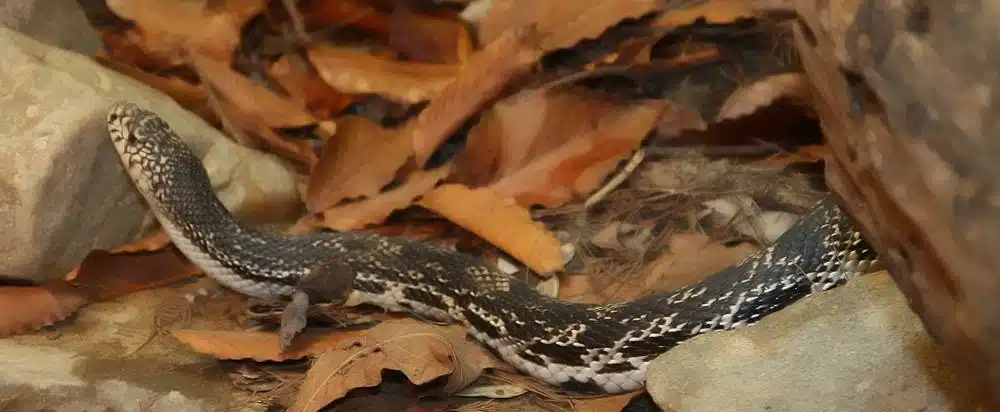
Pine Snakes (Pituophis melanoleucus) are non-venomous and are large snakes growing to 230 centimeters in length. They are powerful with small heads and pointed snouts. The color pattern comprises light ground color with black, red-brown, or brown patches.
They are common in sandy pine-oak woodlands, cultivated fields, rocky deserts, prairies, and pine Flatwoods. They require well-drained soil that is sandy with some vegetation for hibernating and nesting.
The pine snake is known to be very aggressive and even though bites are uncommon, they will deliver a strike. When you approach them, they will hiss loudly, strike, and vibrate the tail. While they are non-venomous, their bites can be very painful.
30. Glossy Swampsnake
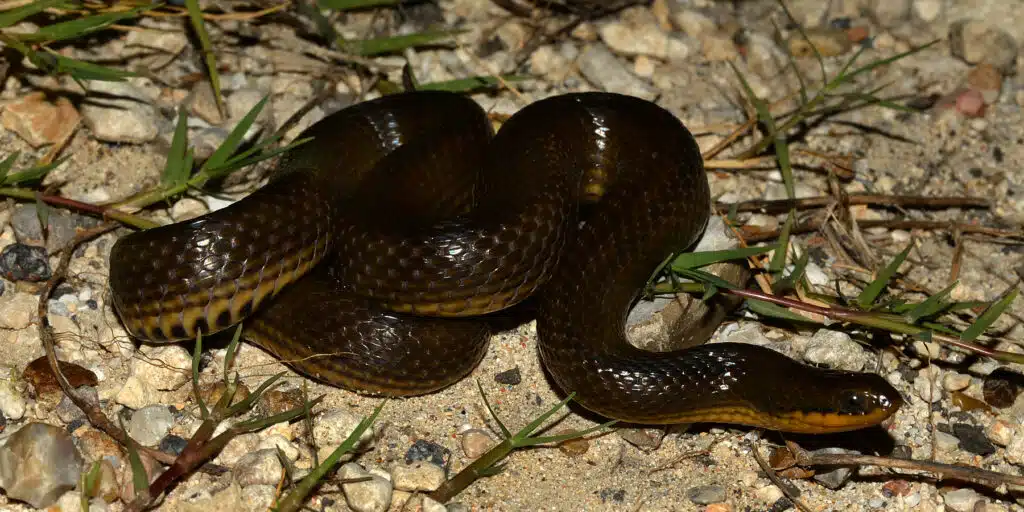
The Glossy Swampsnake (Liodytes rigida) is also known as the crayfish snake and is semi-aquatic. This small snake can grow to forty-one centimeters in length and are heavy-bodied. They are olive brown with two black stripes, that are not always present.
They have a yellow upper lip and a yellow belly with black spots. They are often encountered in the south Mississippi slow-flowing bogs, ditches, swamps, and waters.
31. Eastern Worm Snake
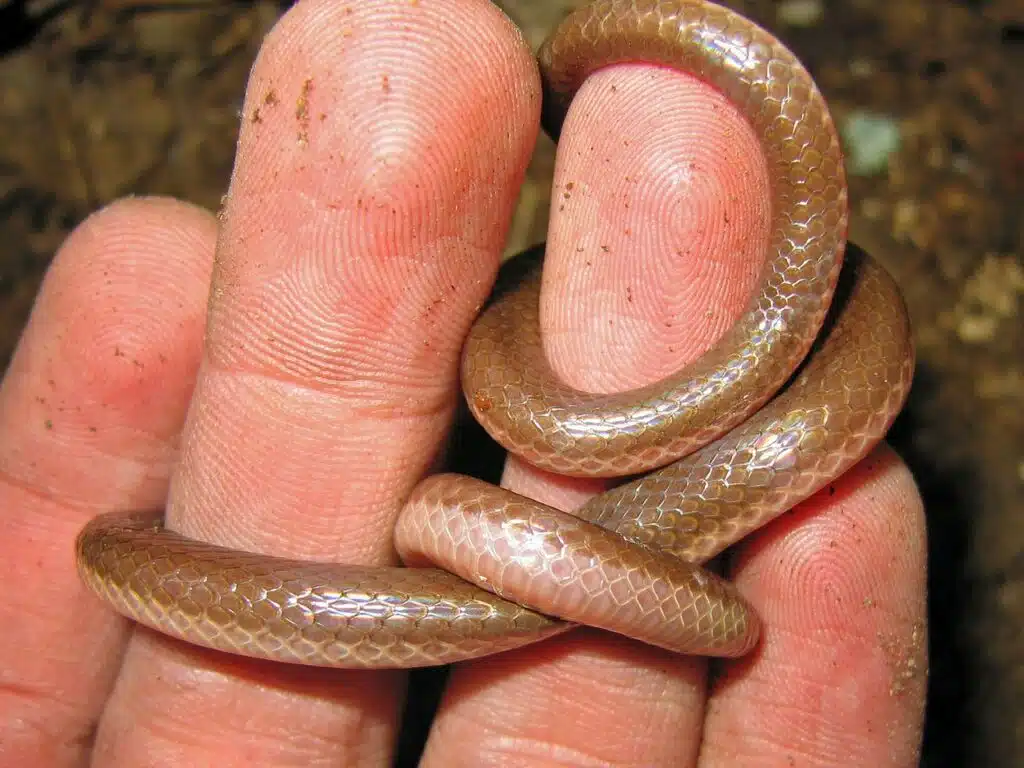
The Eastern Worm Snake (Carphophis amoenus) is often seen in woodlands and wetlands. You may see it in the grasslands adjacent to the woodlands. They are abundant in Mississippi, but very seldom encountered. They spend their time hiding under logs, leaf litter, rocks, or burrowed in woody debris.
They are safe to handle, though they may give off a foul odor but they cannot bite. This small snake only grows to 28 centimeters in length with a smooth and glossy body. There is no pattern and they range from dark brown to light brown with a red belly.
The female is longer than the male. They have small heads with reduced black eyes.
32. Southeastern Crowned Snake
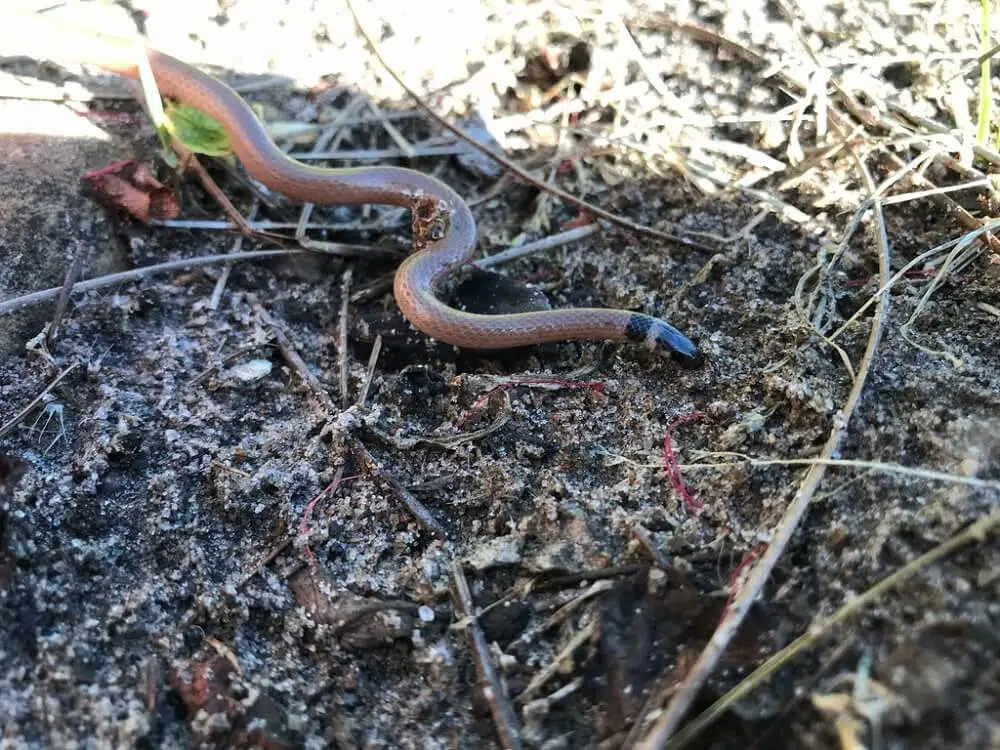
This (Tantilla coronata) is a small, gray-brown to light-brown slender snake with a black pointed head and a cream band between the neck and head. They have a black collar with the rest of the body being red-brown.
The belly is white or light pink. They have smooth scales and grow to 25 centimeters. They are common where there is plenty of organic litter, loose soil, and sandy soil. They enjoy damp and dry woodland habitats.
This is a rear-fanged snake that is not dangerous to humans or pets. They are burrowers and very secretive, which means even in areas where they are in abundance, chances are you will not encounter them.
33. Eastern Milksnake
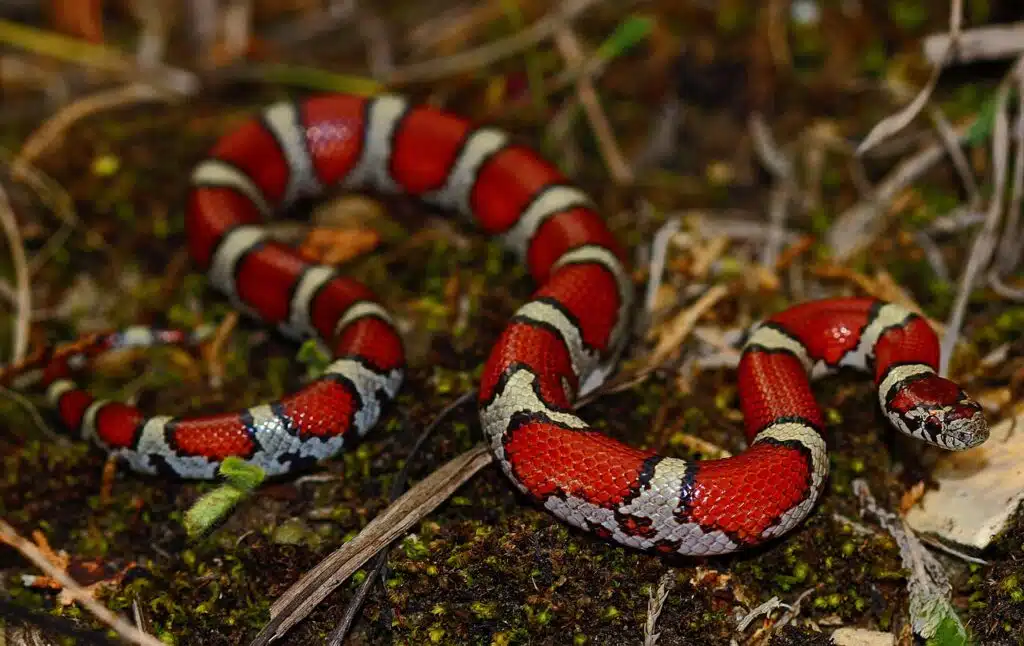
The Eastern Milksnake (Lampropeltis triangulum) can grow to 91 centimeters in length. They are shiny and smooth with a saddled pattern of brown with black edges. Sometimes the saddles are red-brown or red.
The sides of the snake have black-bordered patches that run the length of the snake on a tan or gray background. The patches in the dorsal series are large, while the others are smaller. The belly is a black and white checkered pattern.
This milksnake is a common visitor to rural areas where they find the best feeding and hibernation spaces, including buildings and mammal burrows. They can often be seen in open habitats and forest edges.
34. Coachwhip
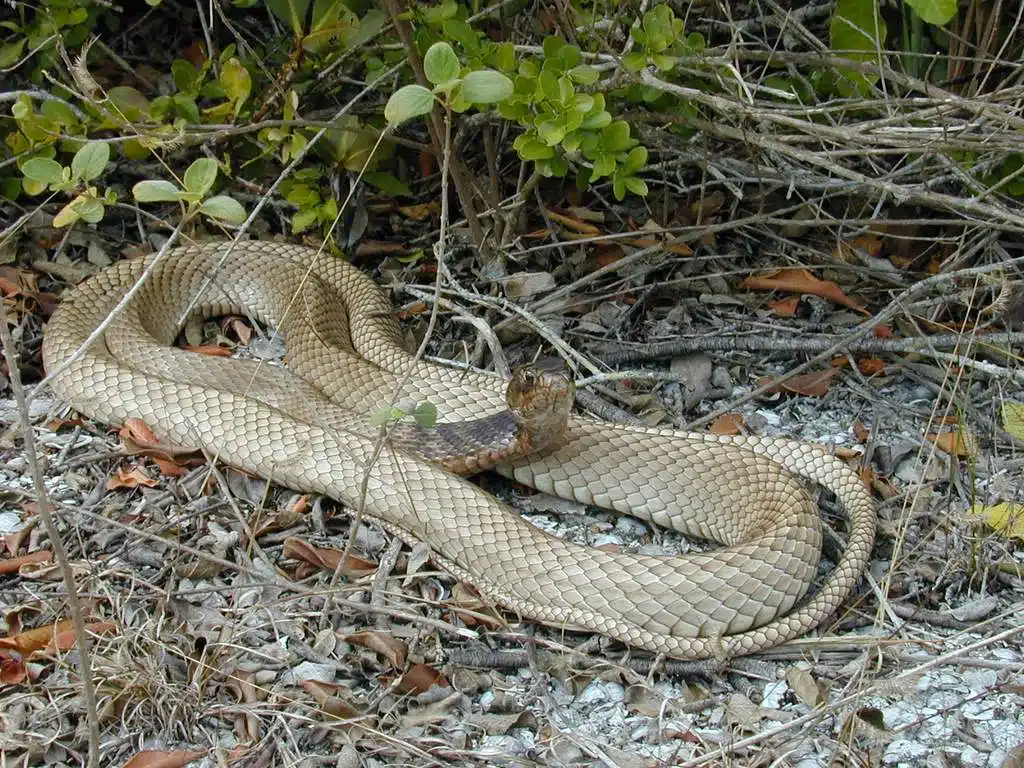
The Coachwhip or whip snake (Masticophis flagellum) is a non-venomous thin bodied snake with a small head and large eyes. The color varies to provide the best camouflage for their habitat. Often they are light brown with darker flecks but in other areas, they are known to be pink.
This snake can grow to 183 centimeters. They are often encountered in open areas, open pine forests, prairies, and fields. They prefer sandhill scrub and coastal dunes.
They are known for holding their head above the vegetation to look for prey before they capture them. They are also excellent climbers and will often climb trees in search of prey.
35. Scarlet Kingsnake
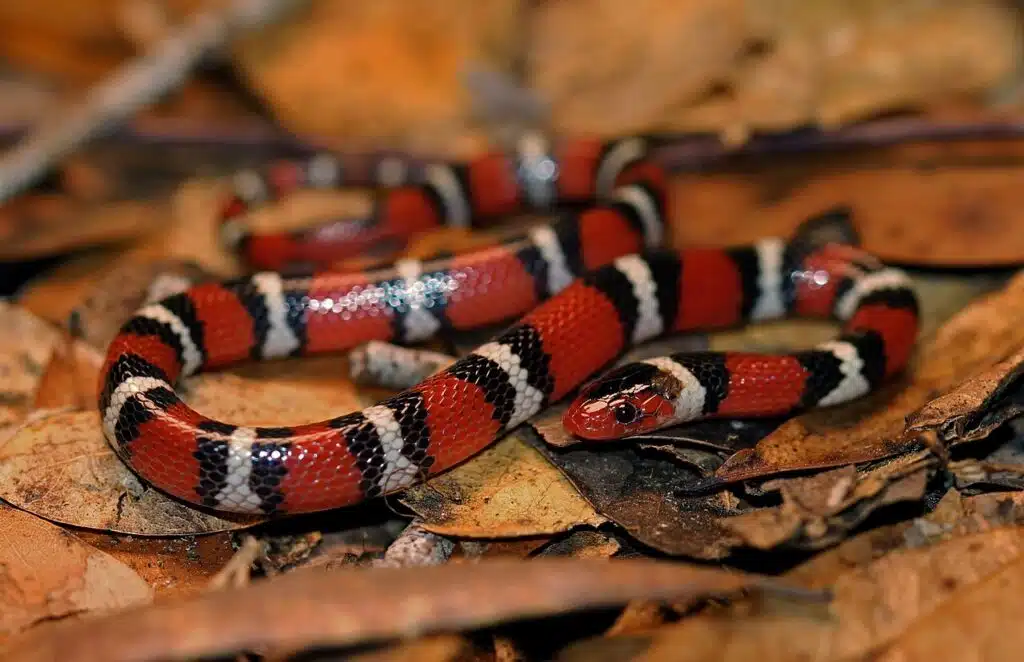
Scarlet Kingsnakes (Lampropeltis elapsoides) are also known as scarlet milk snakes, commonly encountered in pine Flatwoods, pine savannas, pine-oak forests, cultivated fields, and prairies. It’s not uncommon to find one of these non-venomous snakes in your swimming pool.
This small snake can grow to 50 centimeters as a fully-grown adult. They have a tri-colored pattern of red, white, black, and shades of yellow bands. This mimics the venomous coral snake. If you are worried if you have encountered a coral snake or scarlet kingsnake in areas east of the Mississippi River, use the phrase “red face, I’m safe.”
The scarlet kingsnake has a red snout, helping differentiate it from the coral snake which has a black snout. As juveniles, the scarlet kingsnake has red, black, and white banding, which changes to yellow as they age.
36. Graham’s Crayfish Snake
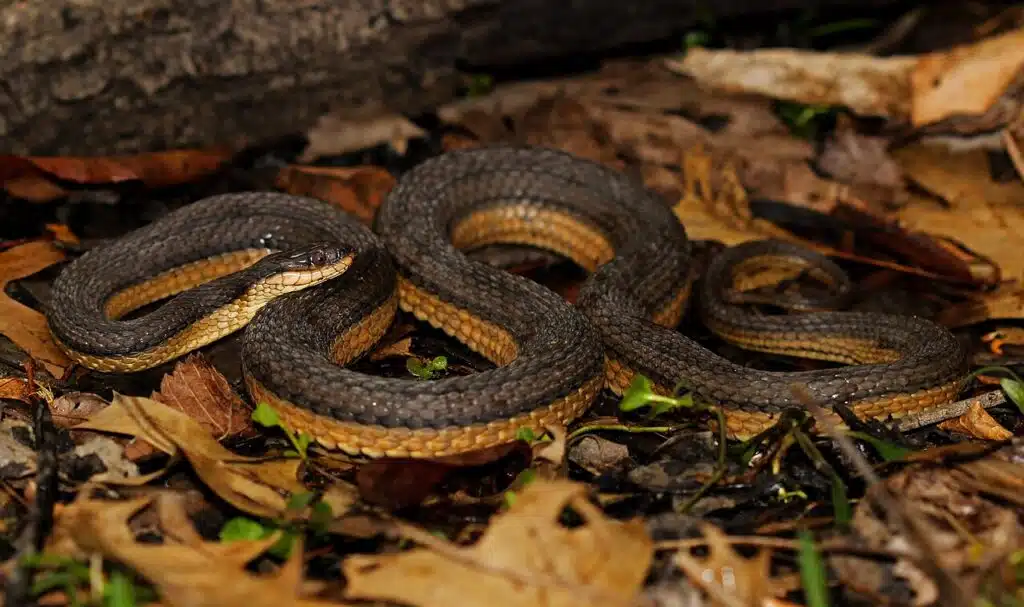
Graham’s Crayfish Snake (Regina grahamii) is a non-venomous semi-aquatic snake that can grow to 71 centimeters in length. They are known to grow up to four feet with the maximum recorded snake being 119 centimeters.
This snake is gray or brown with a faint stripe down the body. There are lateral stripes that are white, tan, light yellow, or cream. The belly is the same color as the lateral stripes.
This snake can be found along rivers and streams. They are often found in roadside ditches where there is ample crayfish. They usually hide under debris, rocks, and logs along the water’s edge.
37. Mole Kingsnake
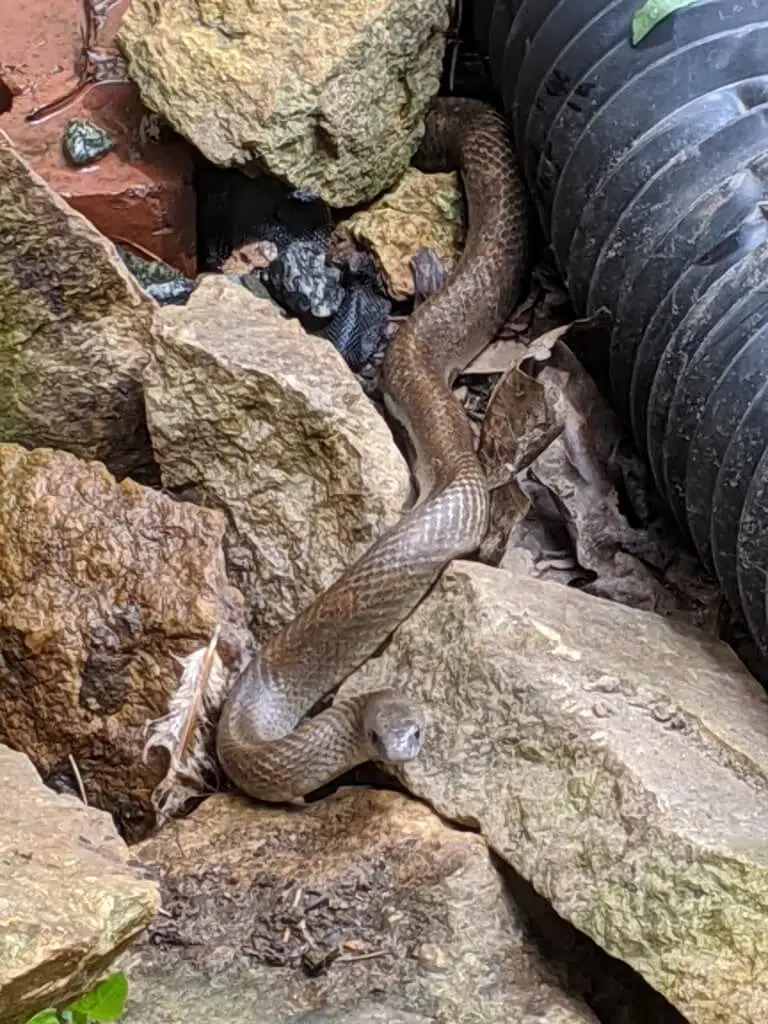
The Mole Kingsnake (Lampropeltis rhombomaculata) is a medium-sized, light brown, or gray snake with dark brown, red-brown, or orange patches down the length of the body. They can grow to more than 100 centimeters in length and are often mistaken for the venomous copperhead.
As juveniles, their colors and markings are more vivid. They have red coloration on the head. This snake prefers open fields with dry soil. They are secretive snakes and will vibrate their tails if they feel threatened or harassed. This nocturnal snake is often seen on the roads at night
38. Prairie Kingsnake
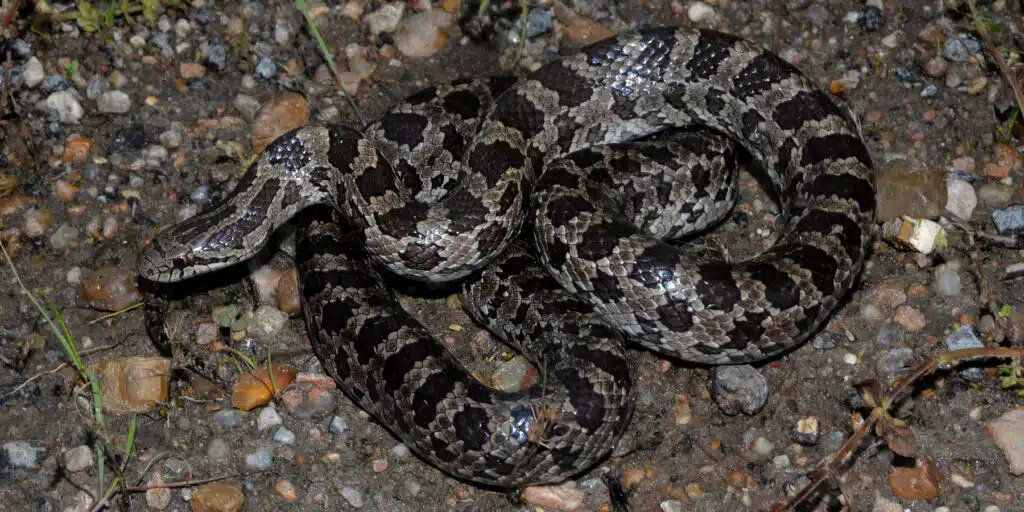
The Prairie Kingsnake (Lampropeltis calligaster) is light brown or gray with dark gray or red-brown patches down the length of the body. They can grow to more than 100 centimeters in length and are often a solid brown, as their markings fade with age.
As juveniles, they have a brown stripe down their backs. There are two black spots behind the head and smaller spots on the sides of the stripe. These snakes are commonly found under logs and debris, in abandoned structures, and inside tree trunks. They are very secretive and only found if you actively search for them.
39. Rainbow Snake
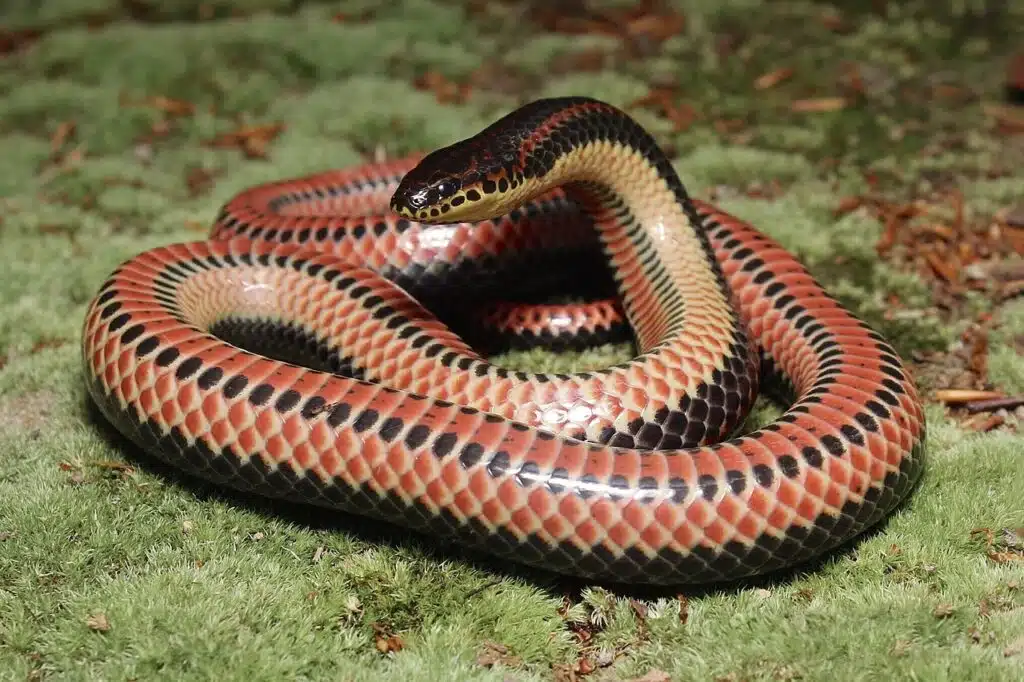
Rainbow Snakes (Farancia erytrogramma) are aquatic non-venomous snakes that have smooth, glossy blue-black scales with red stripes. They have a spiny tip on their tail, which they use as a probe.
Some adults have yellow on the side of their heads. This snake can grow to 122 centimeters in length with females being larger than males. These snakes can be encountered in aquatic habitats including marshes, blackwater creeks, sandy coastal plains, slow-moving streams, and cypress swamps.
These snakes are seldom seen due to their secretive nature. They spend their lives in water, hiding in aquatic vegetation. They are excellent swimmers and will burrow into the sand or mud if disturbed. If you happen to catch one, they are not aggressive and will not bite.
40. Eastern Indigo Snake
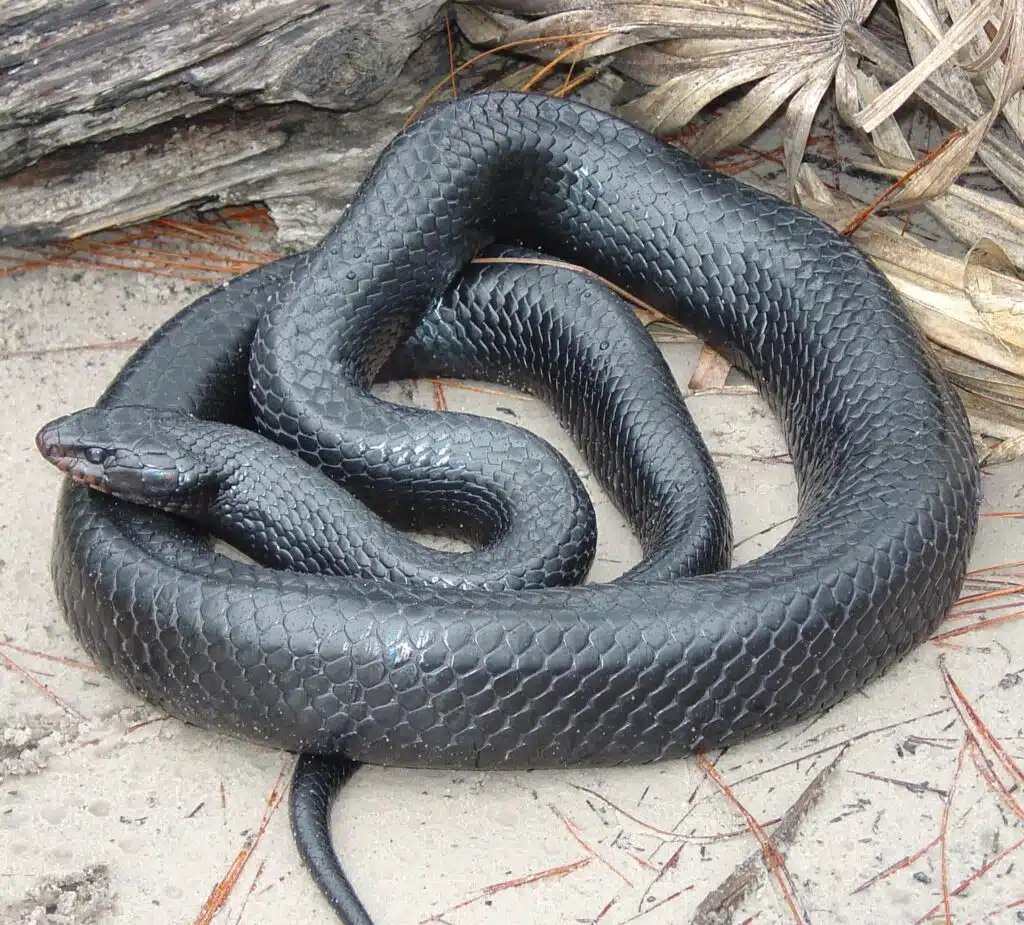
The Eastern Indigo Snake (Drymarchon corais couperi) is large and blue-black with some having a tan on the throat, chin, and cheeks. This non-venomous snake is glossy, which gives it a purple-black color in the light.
They can grow to an impressive 2.8 meters, which is more than nine feet in length. The males are larger than the females. They can weigh up to five kilograms.
This snake lives in hardwood forests, cypress swamps, pine Flatwoods, and moist hammocks. They flatten their neck and hiss while vibrating their tail if they feel threatened. Despite their large size, they are completely harmless and seldom bite if you pick it up gently.
41. Queen Snake
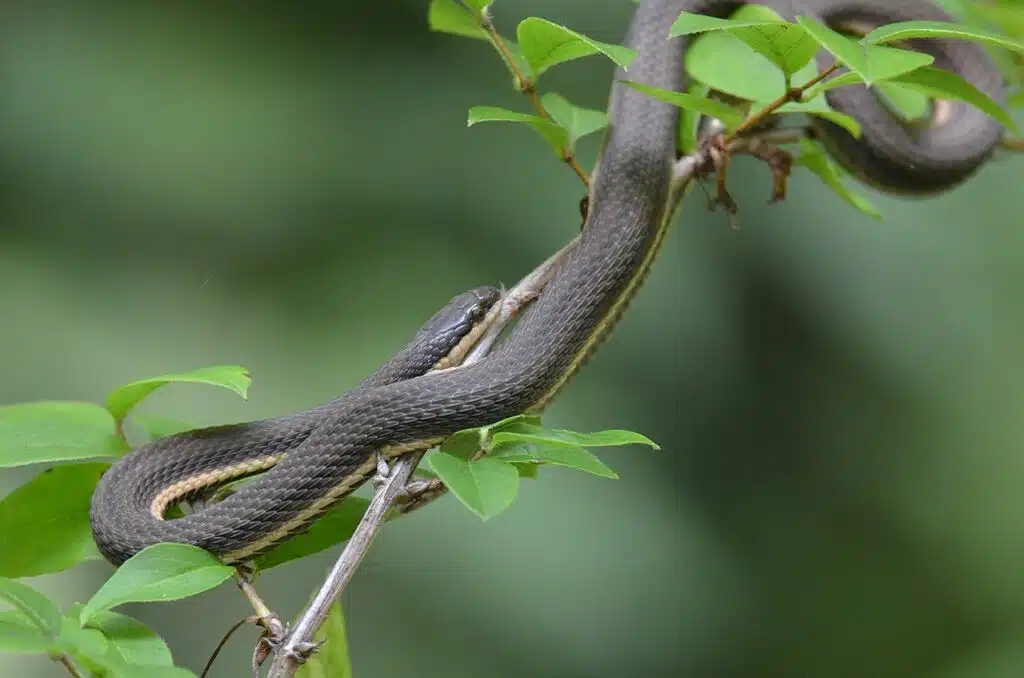
Queen snakes (Regina septemvittata) are non-venomous semi-aquatic snakes that look similar to garter snakes. The snake is olive, dark brown, or gray with peach or yellow stripes. They also have stripes that run down the length of the belly, which helps you identify them.
They have a narrow head and can grow to 61 centimeters in length. Females are larger than males. They are always found near water, due to their diet which is primarily freshwater crayfish.